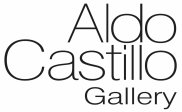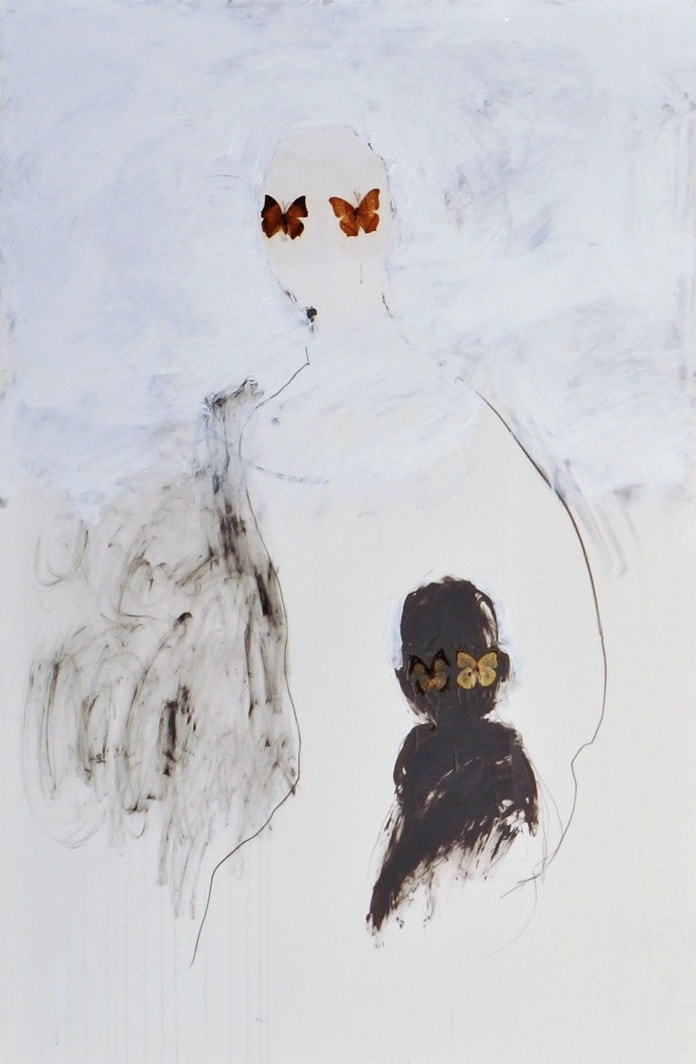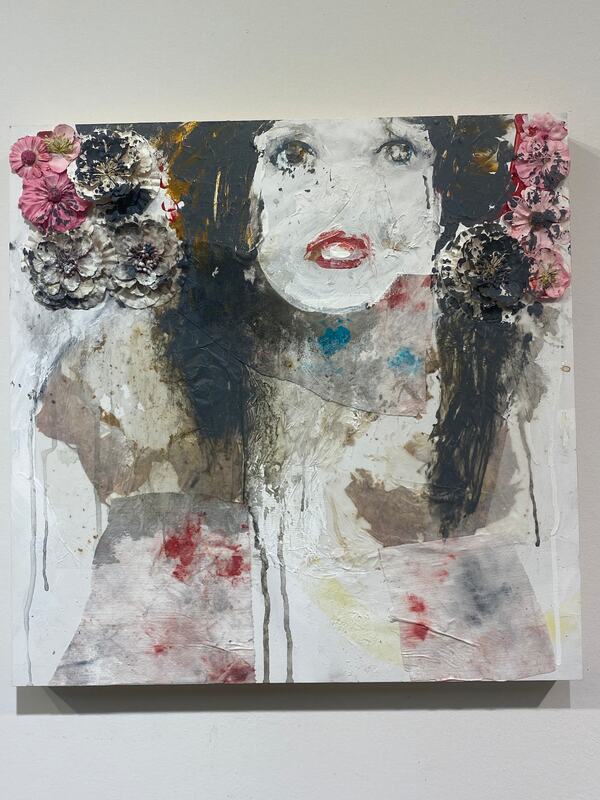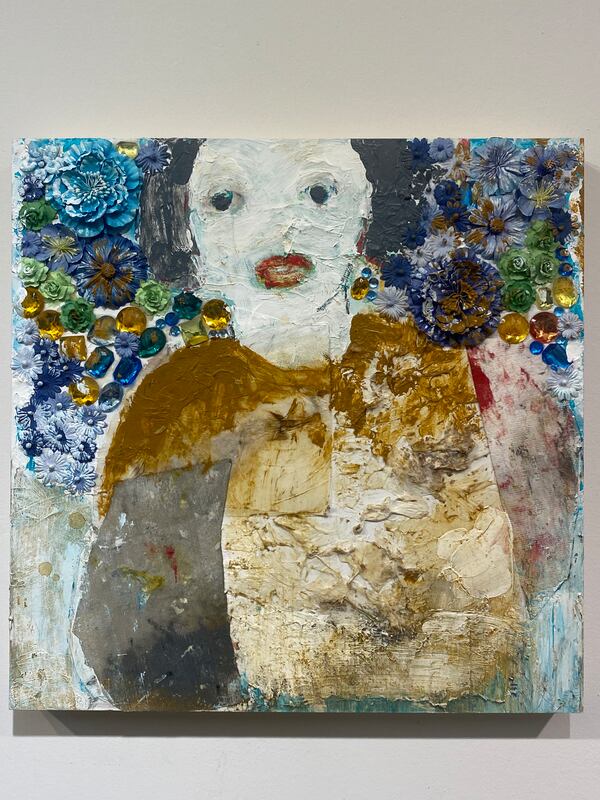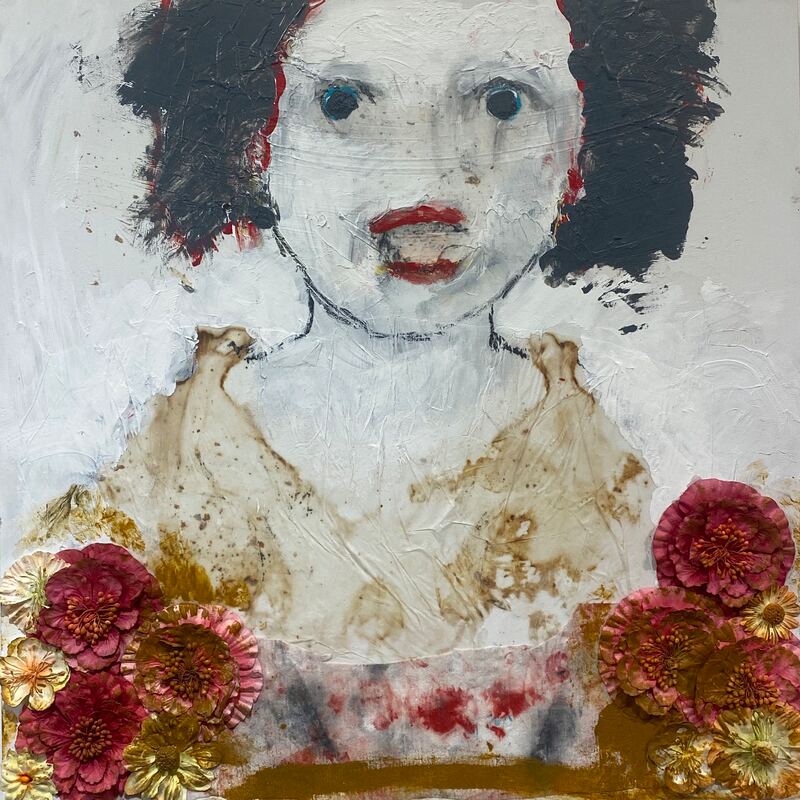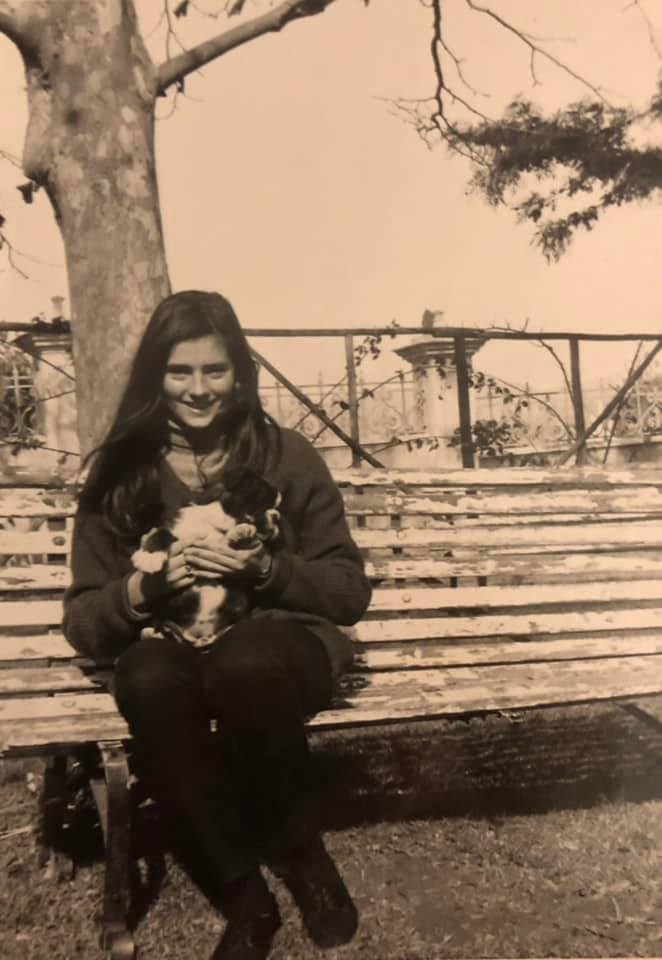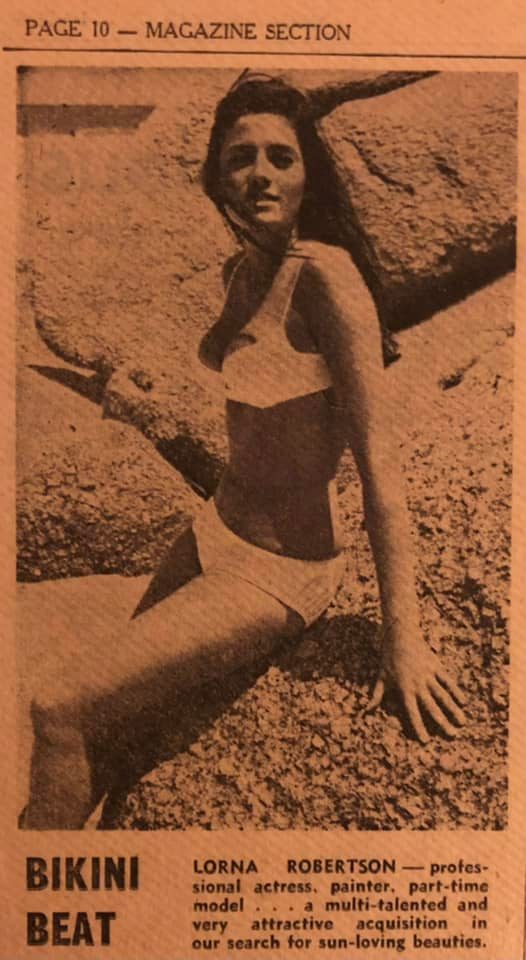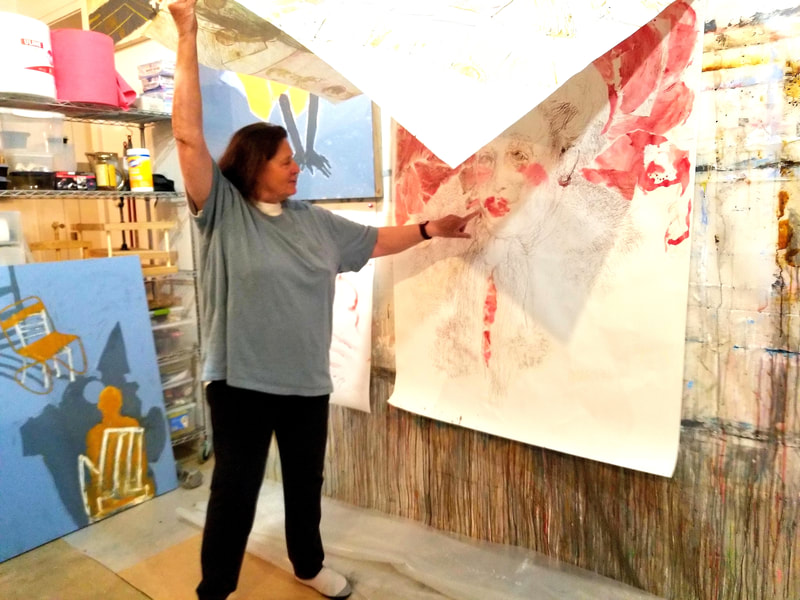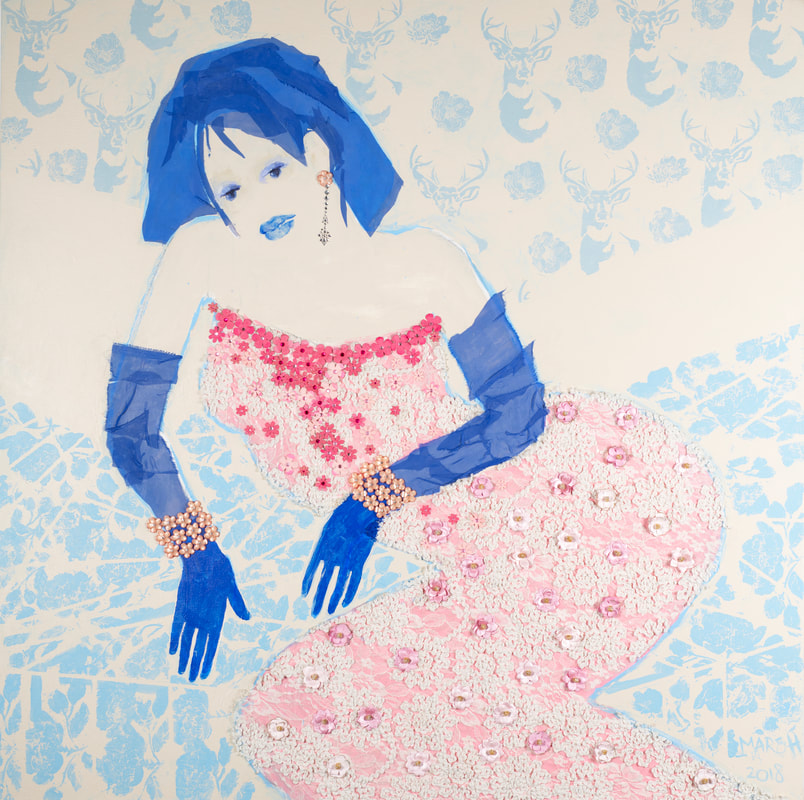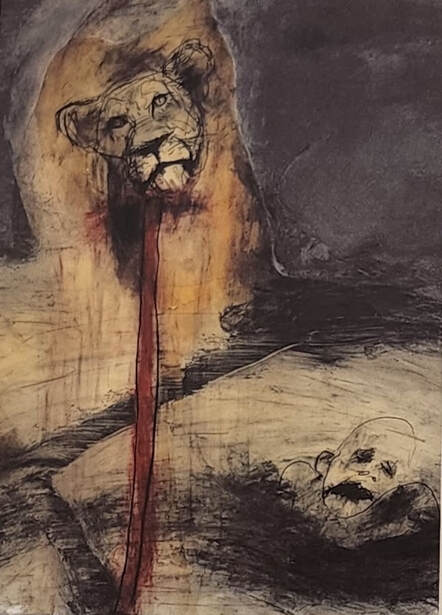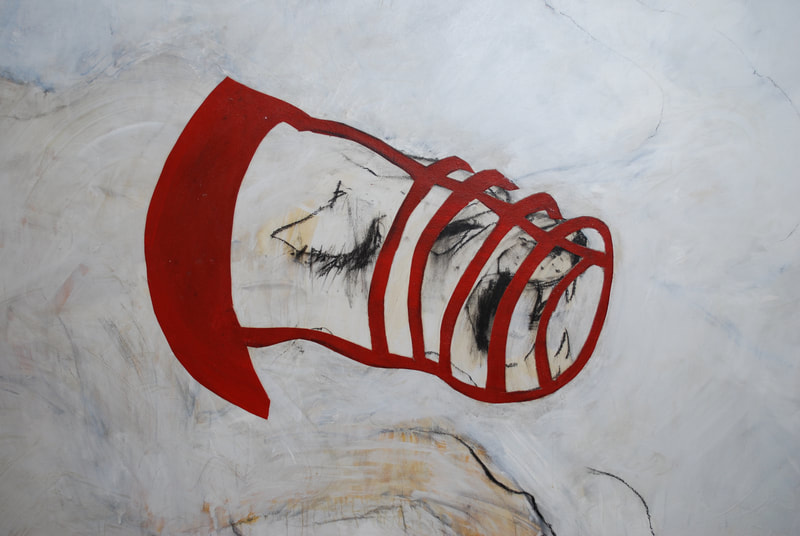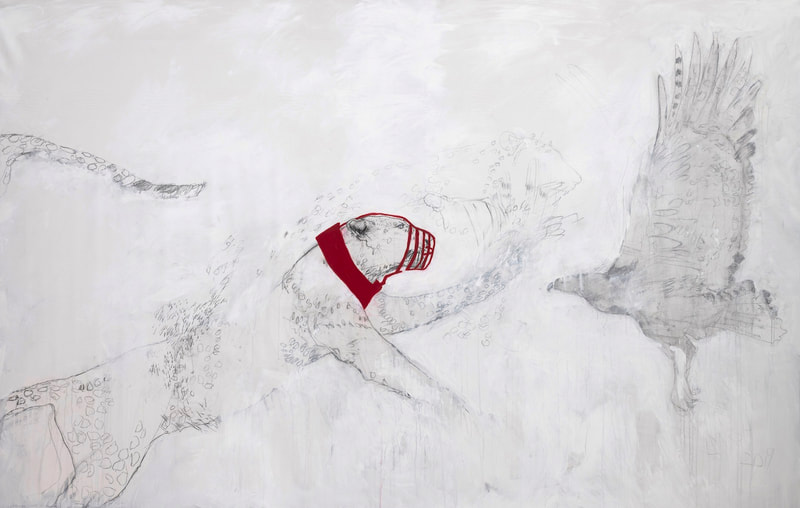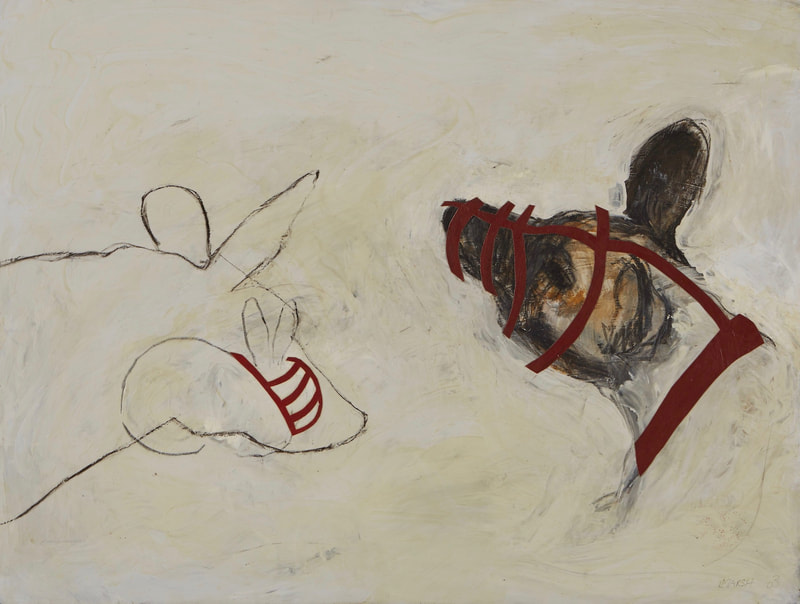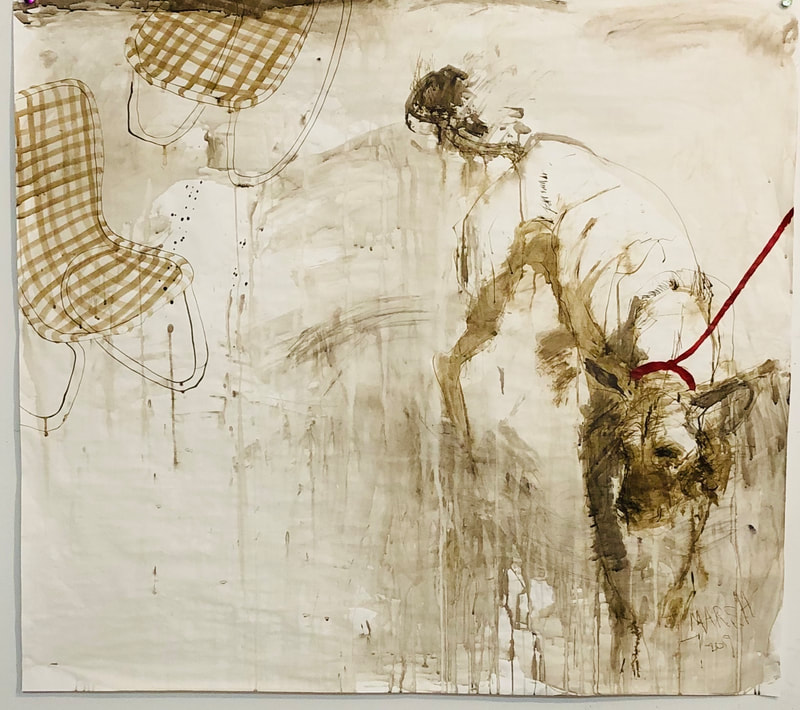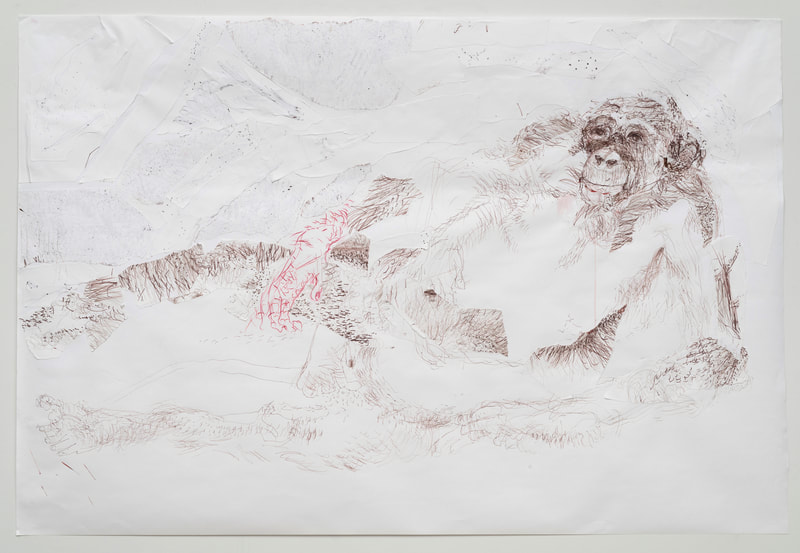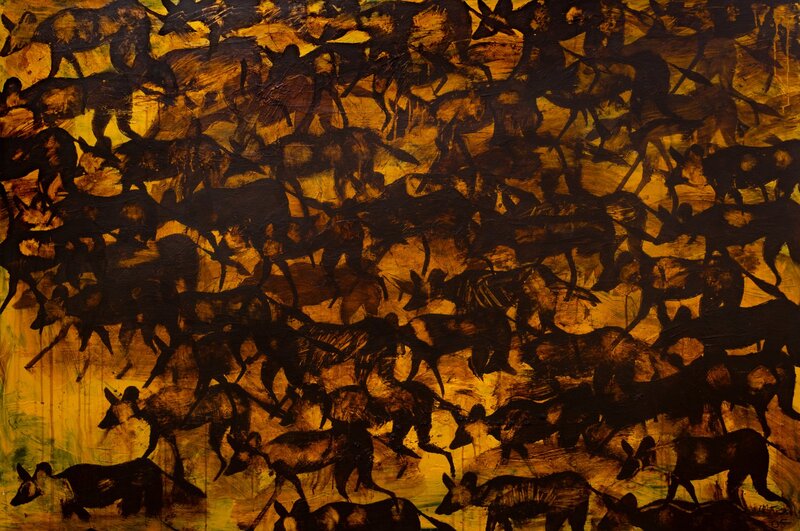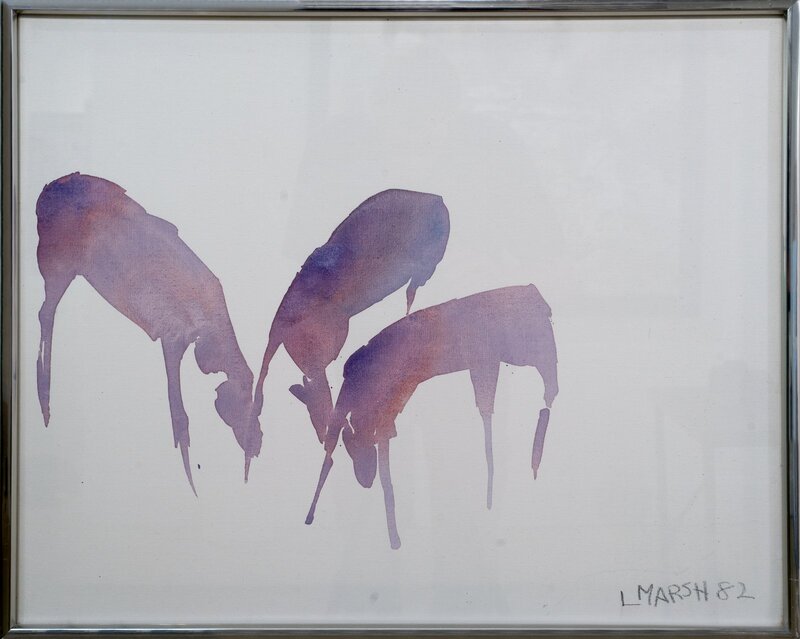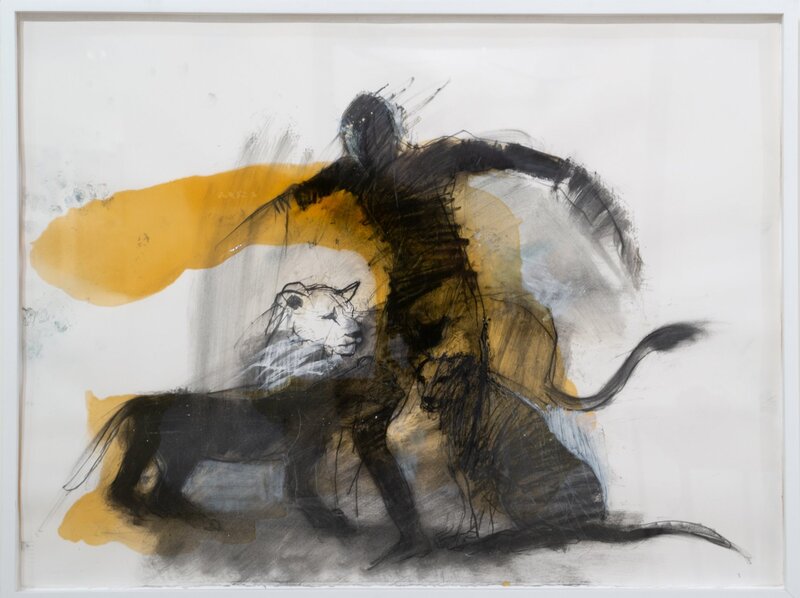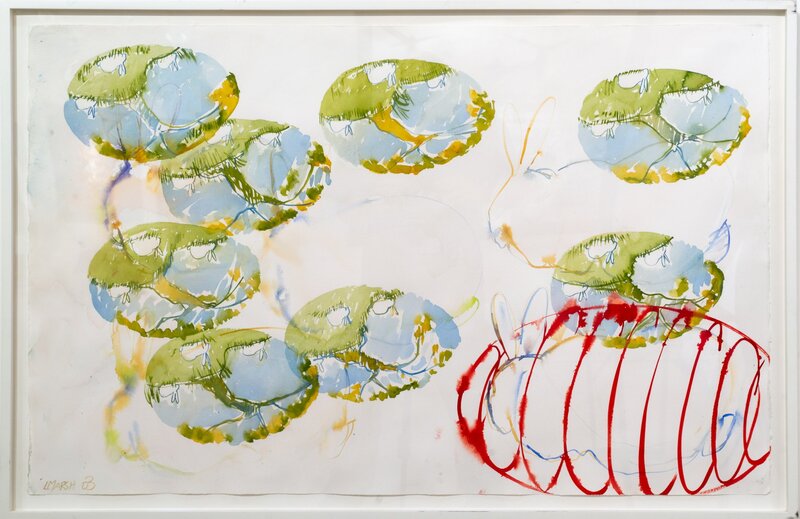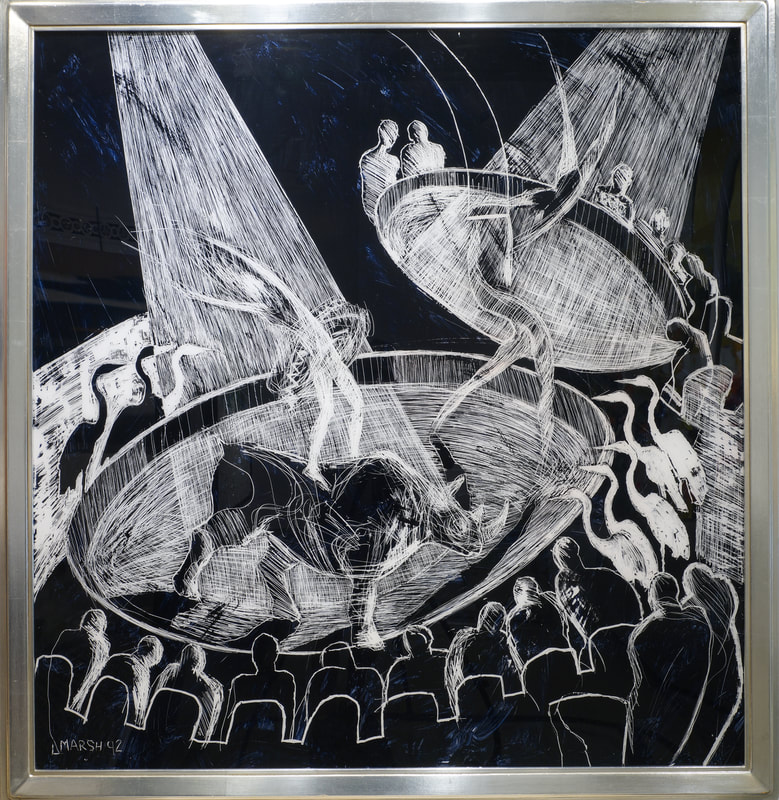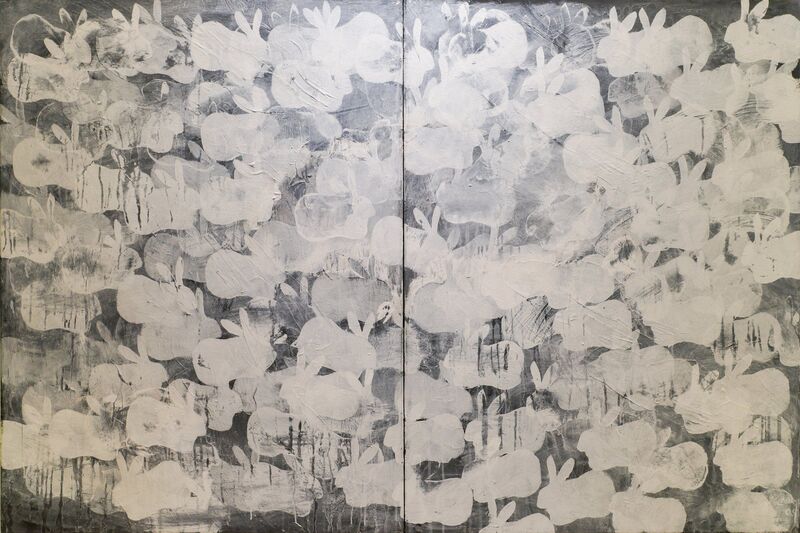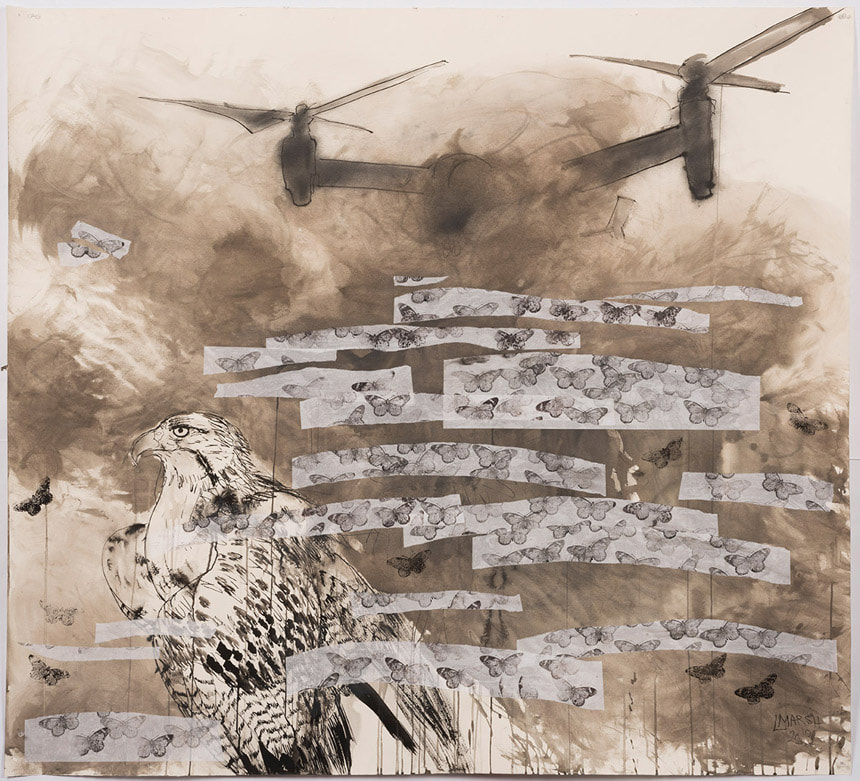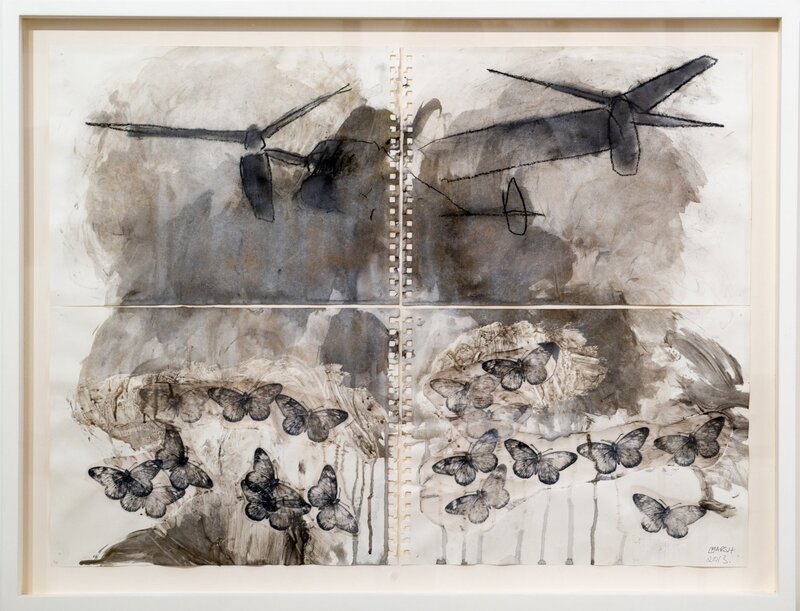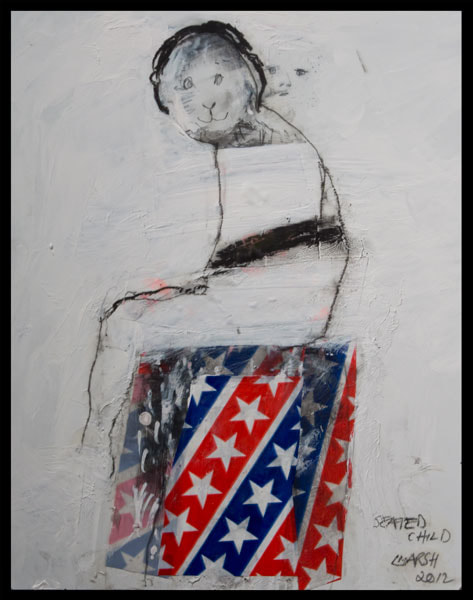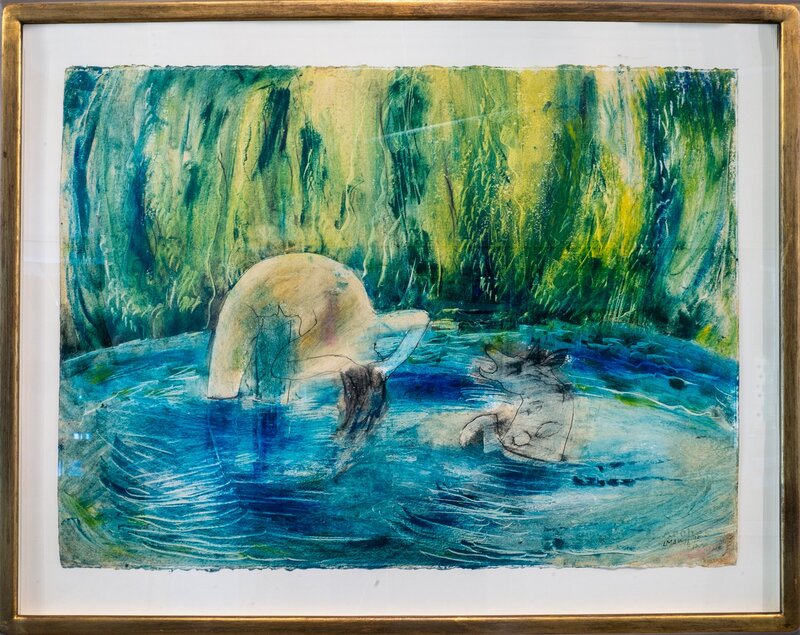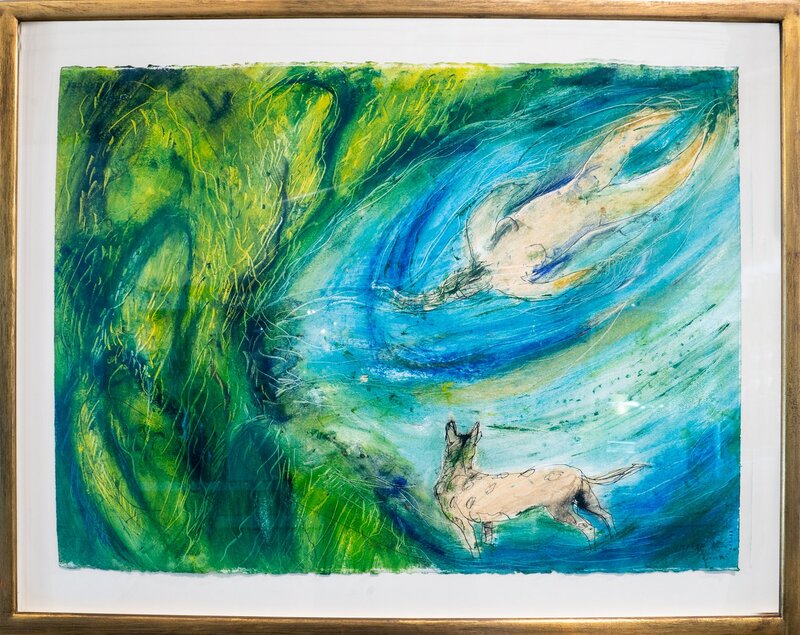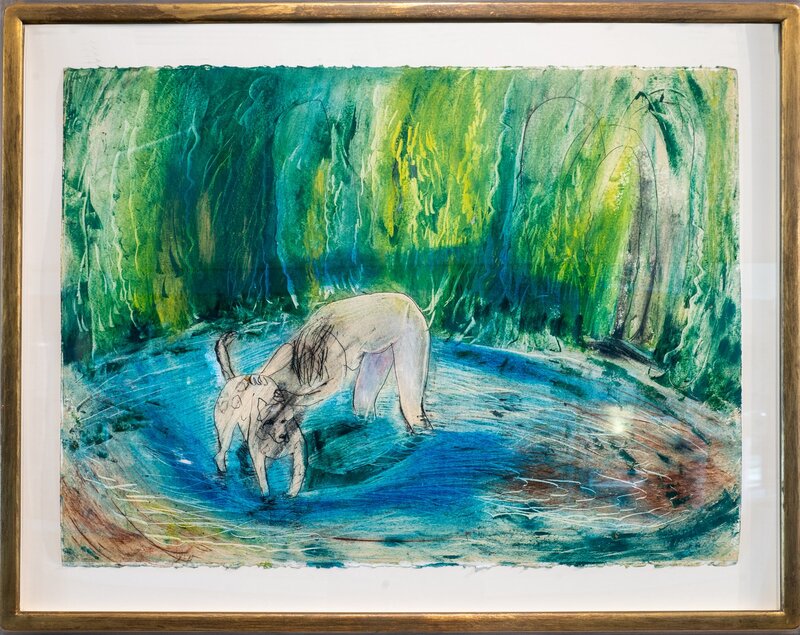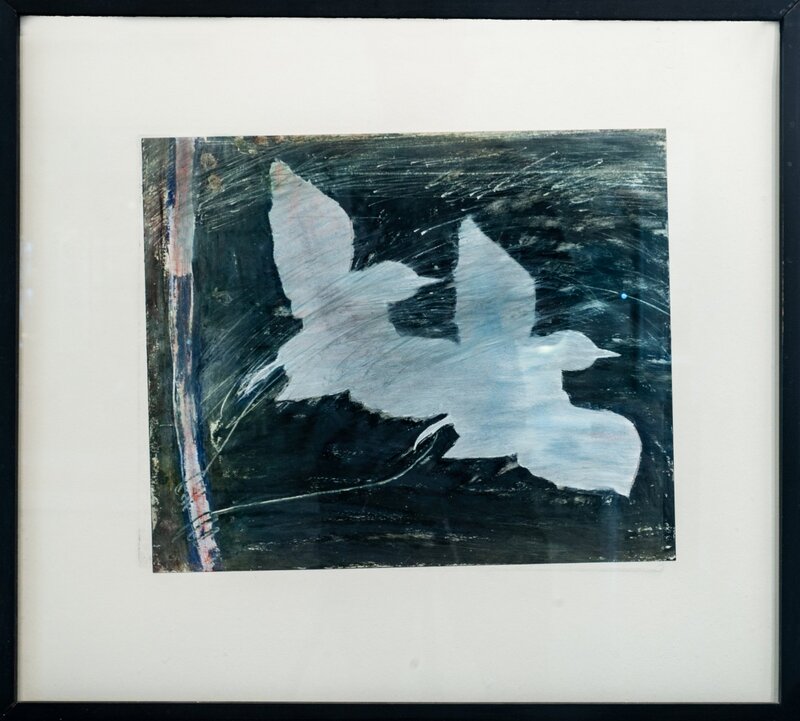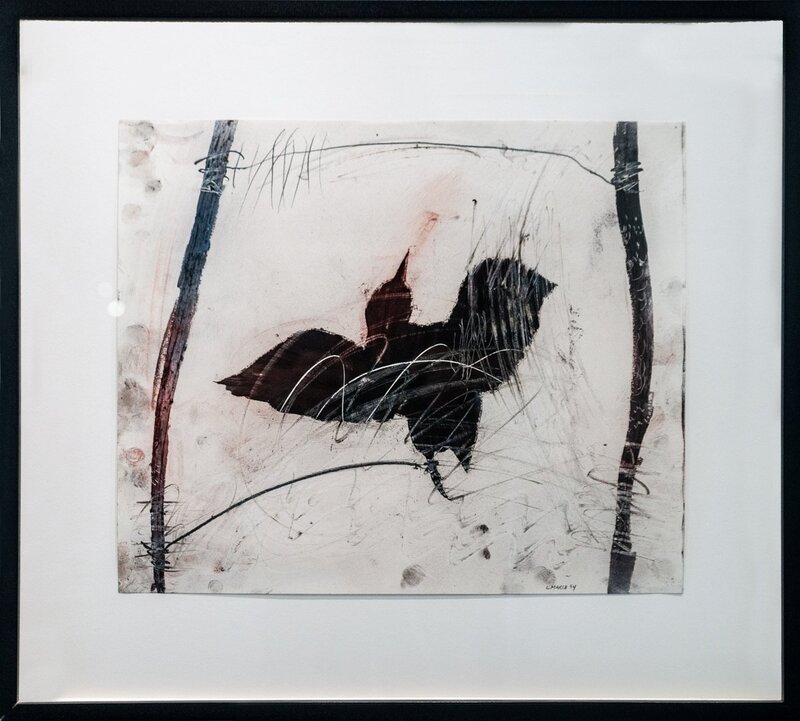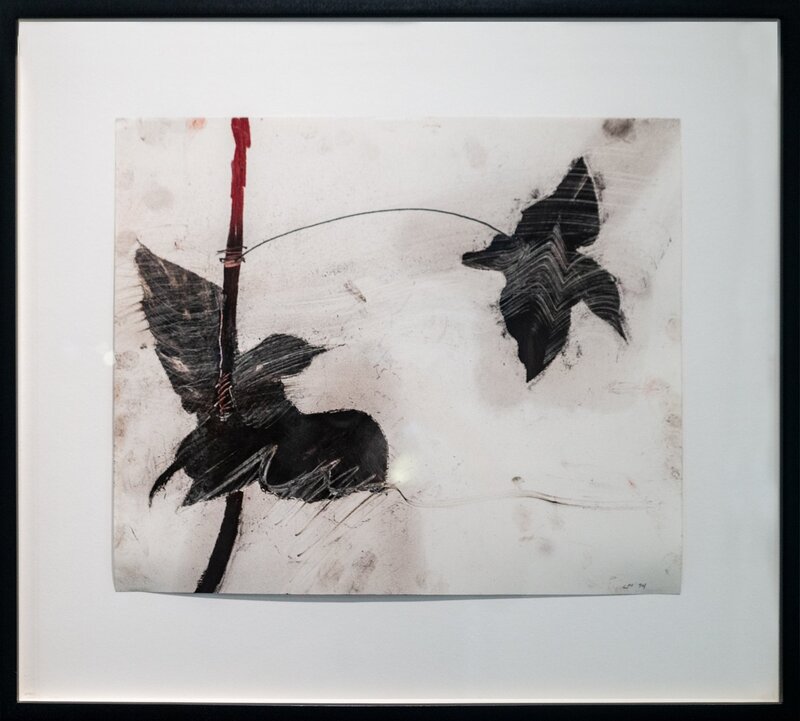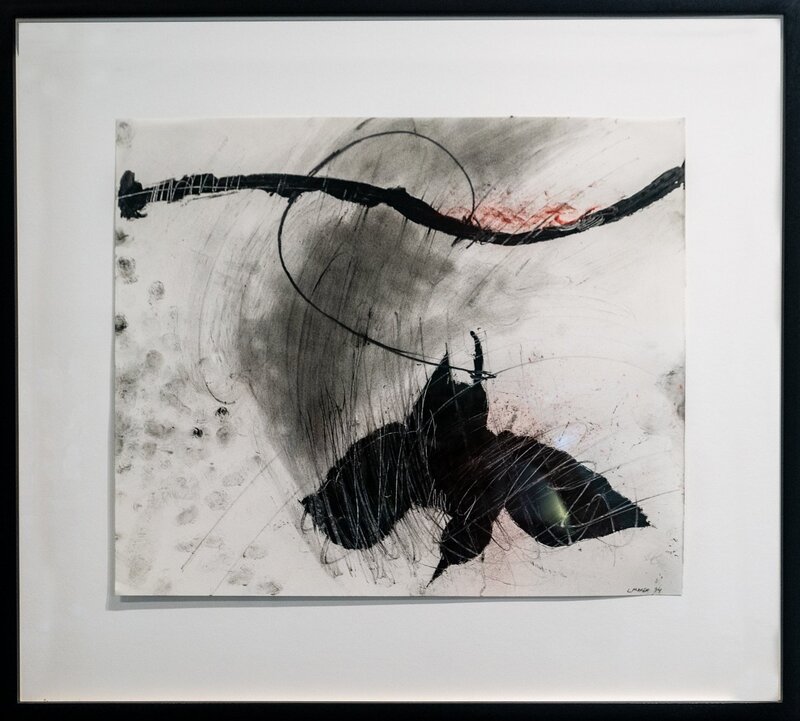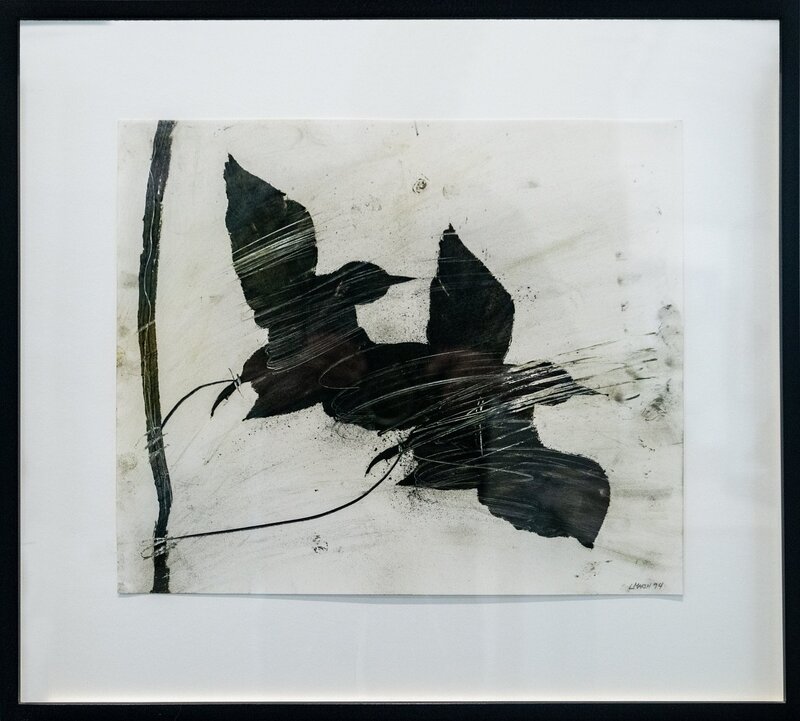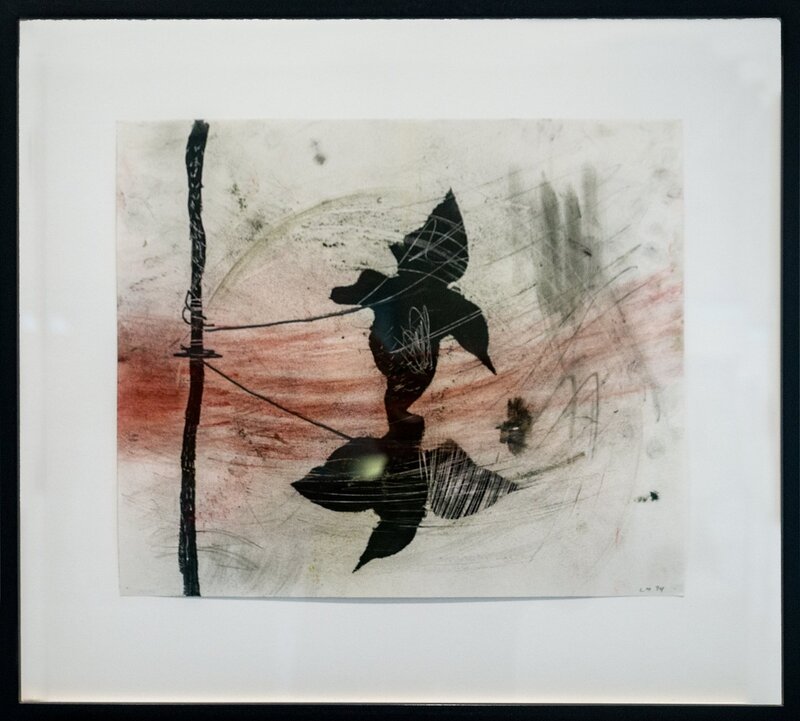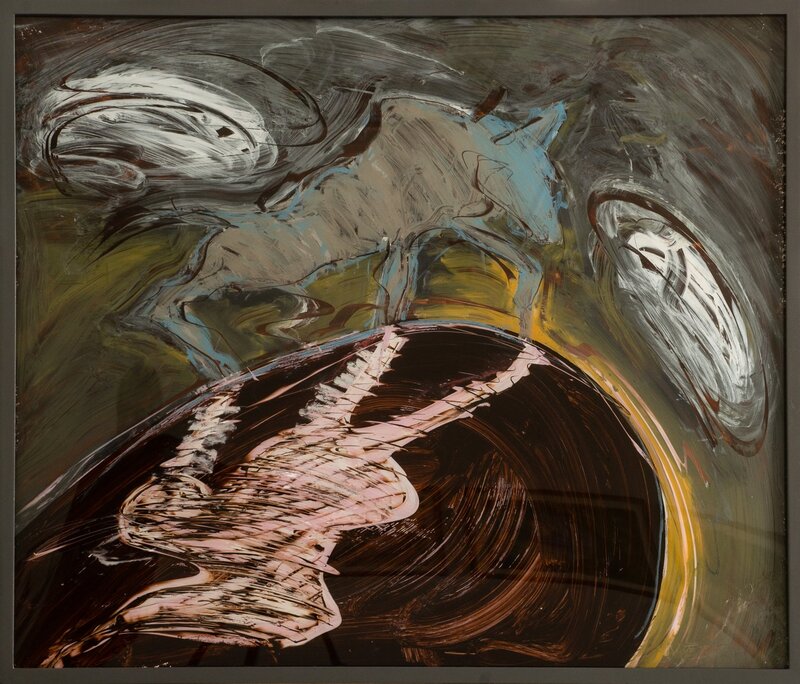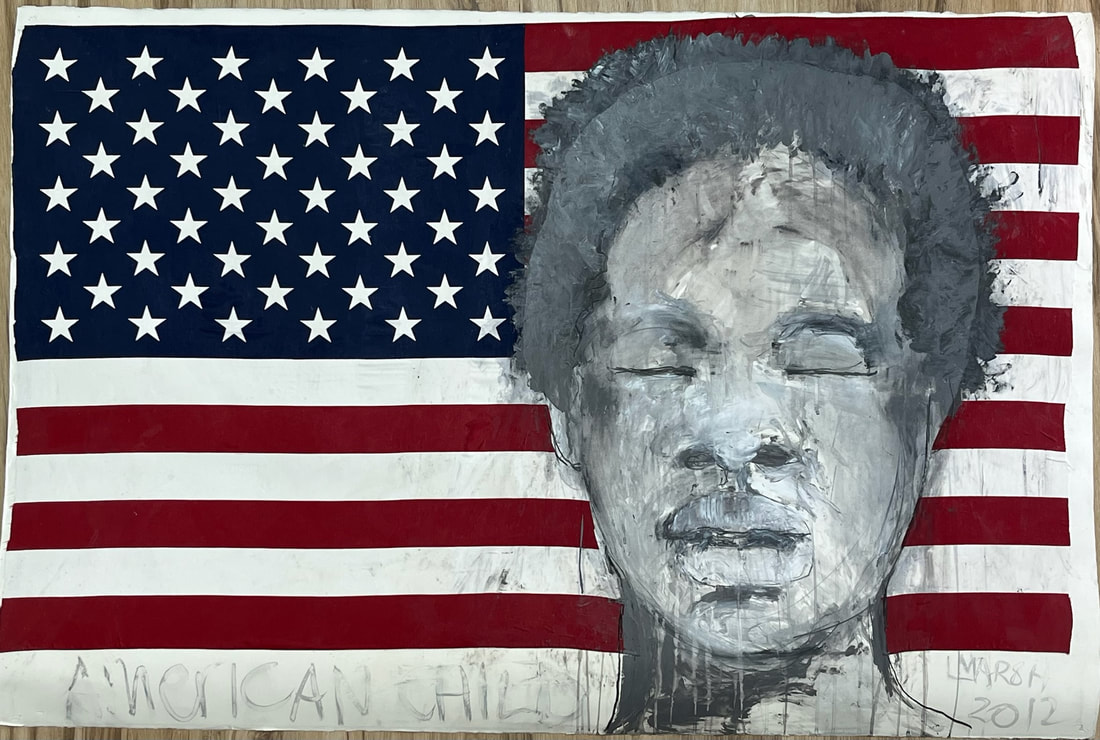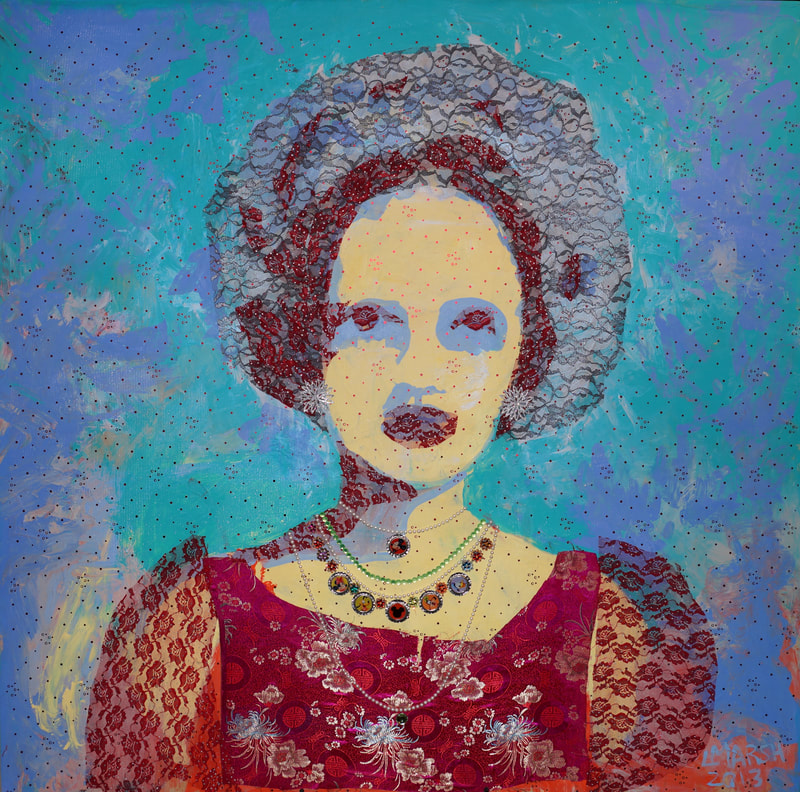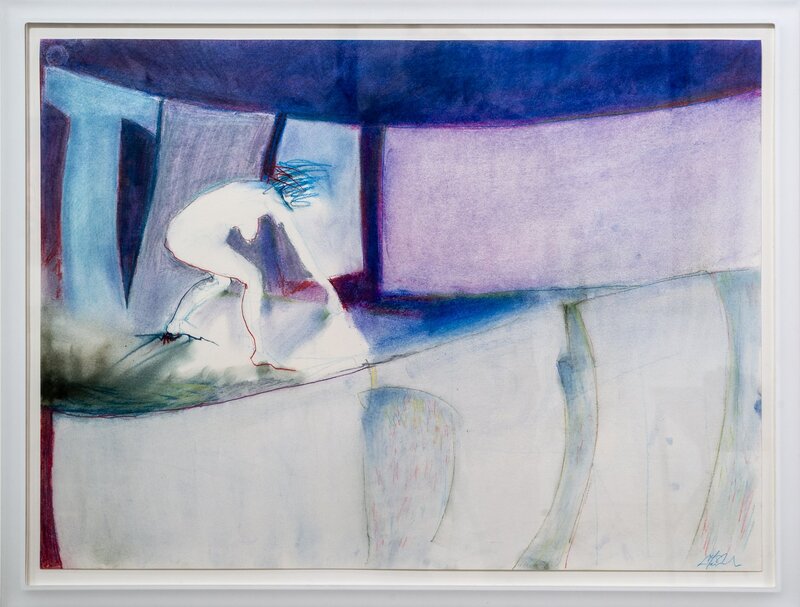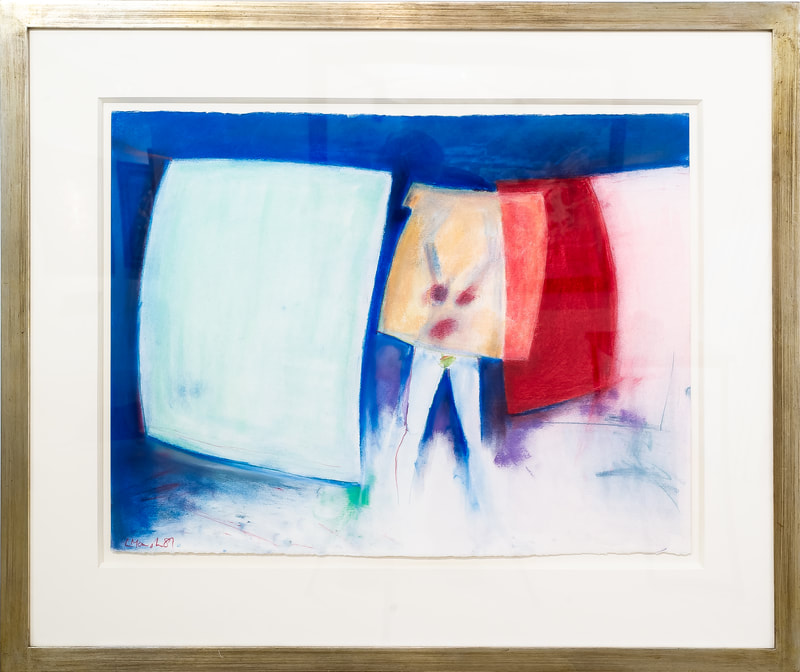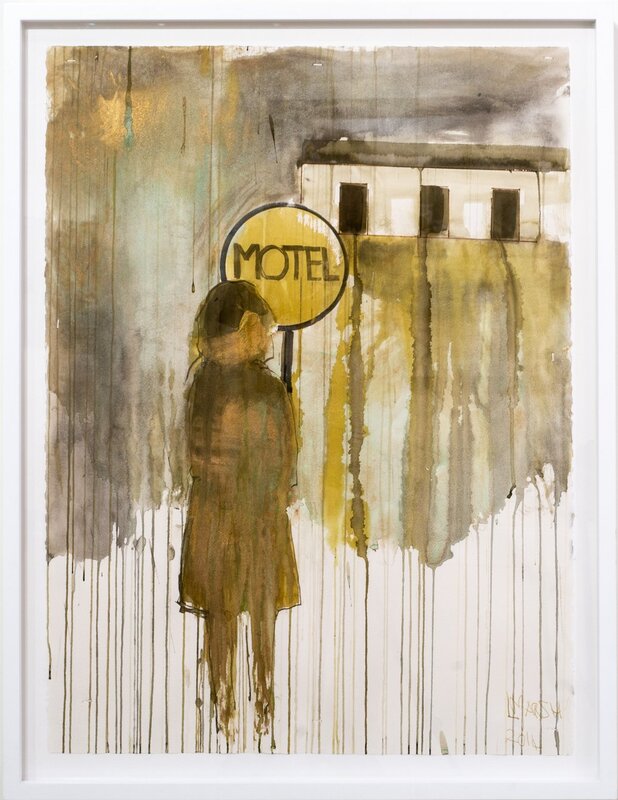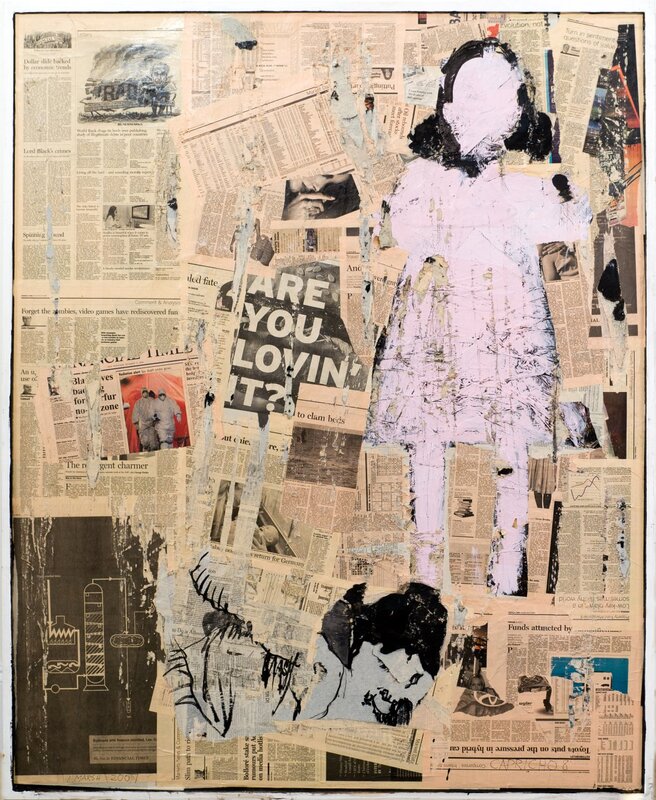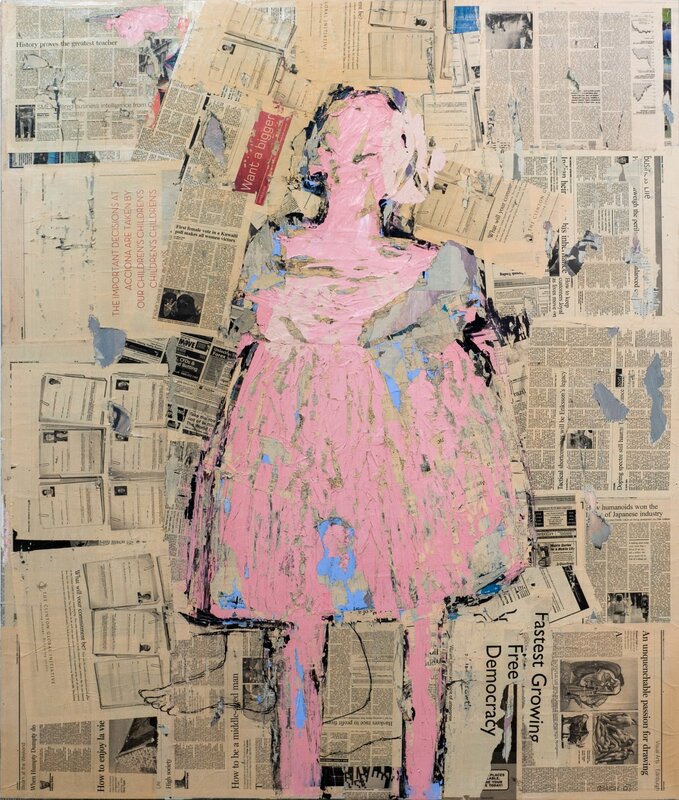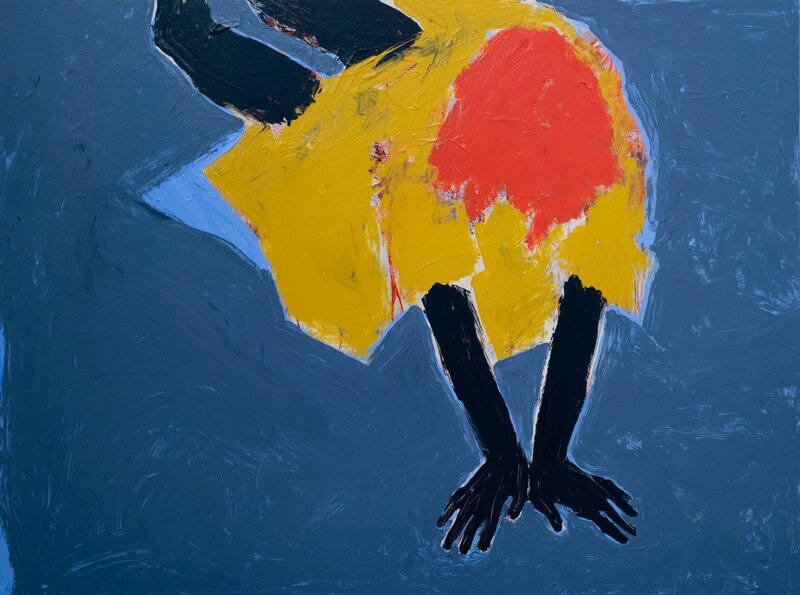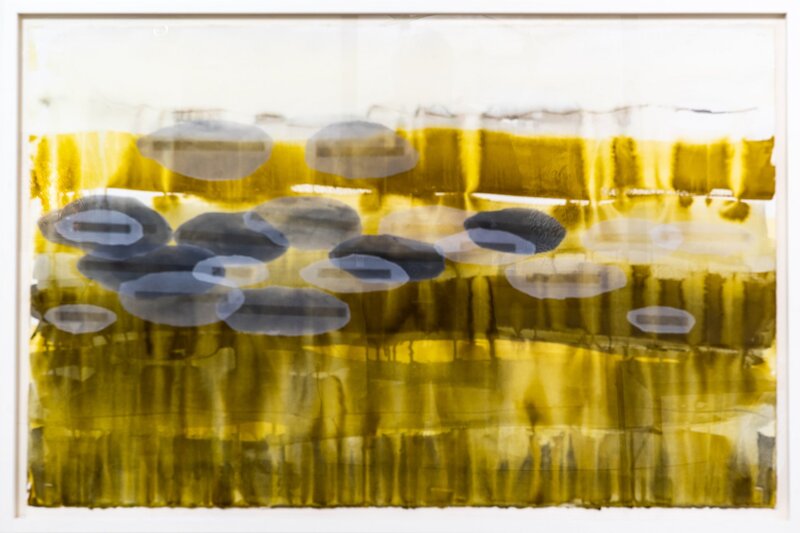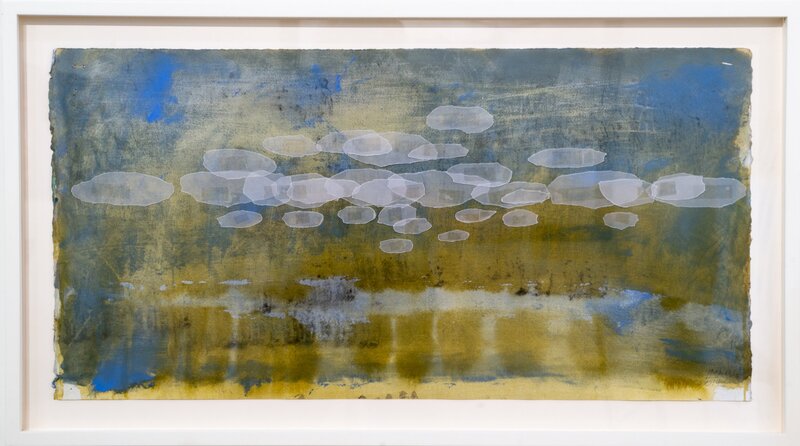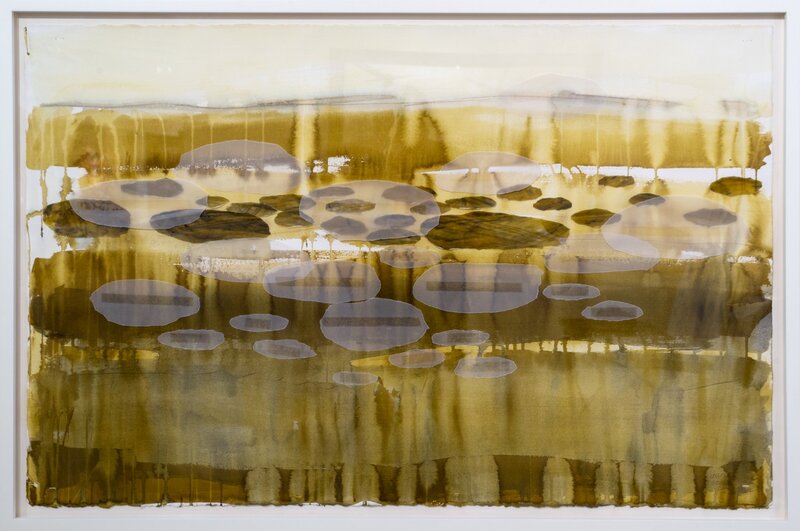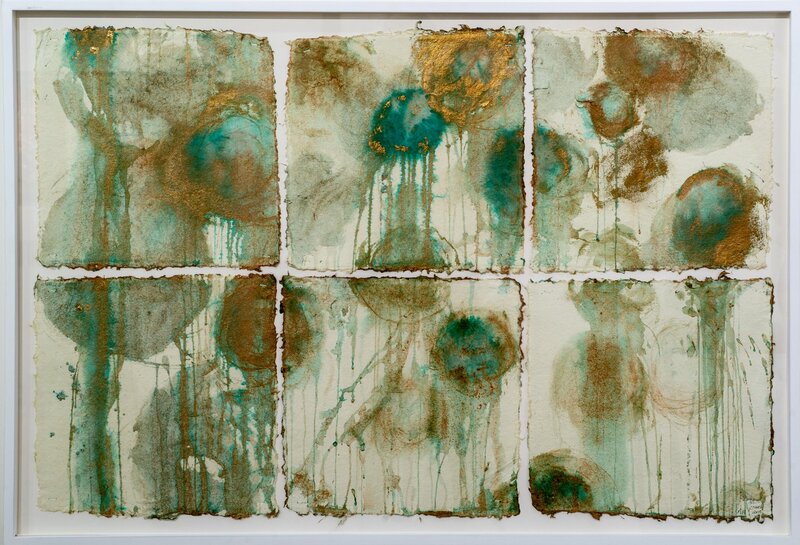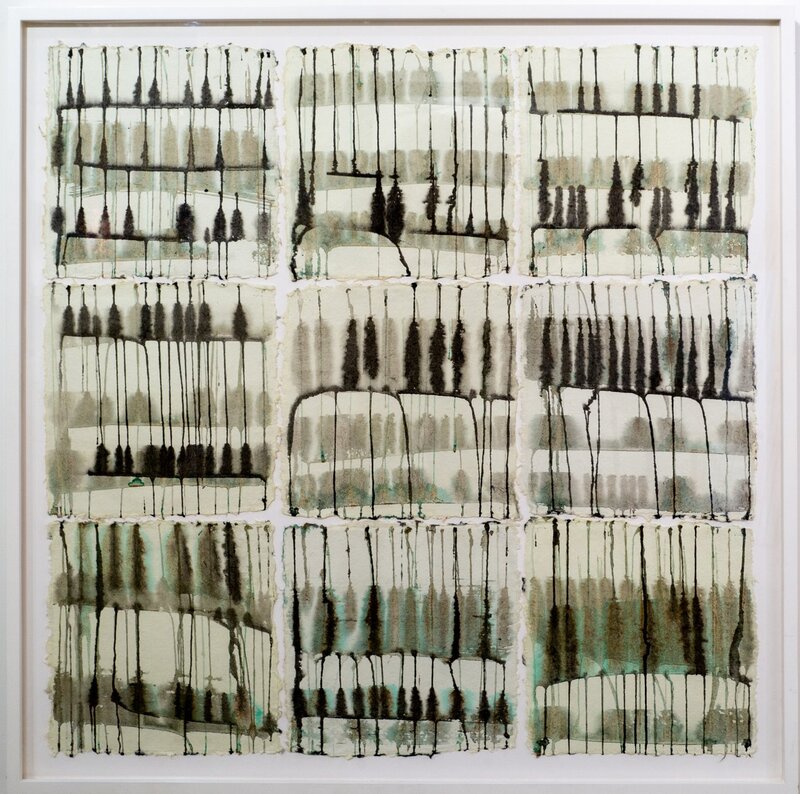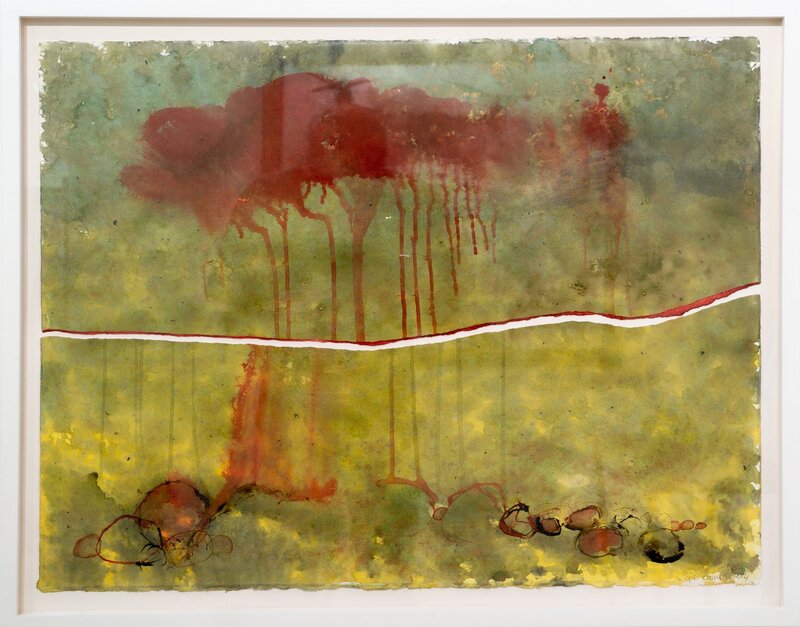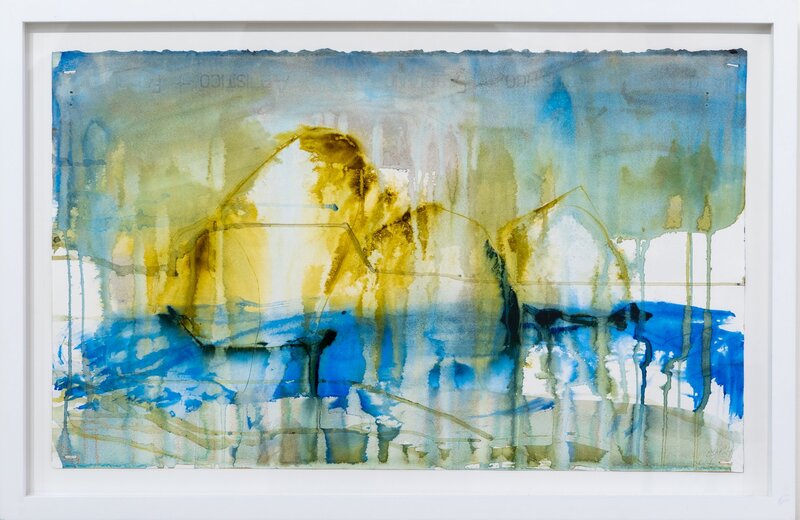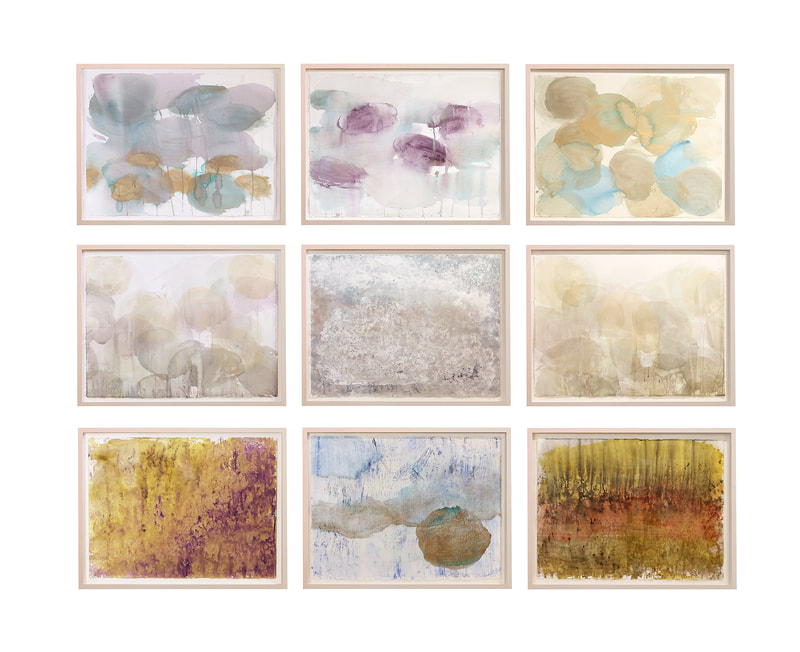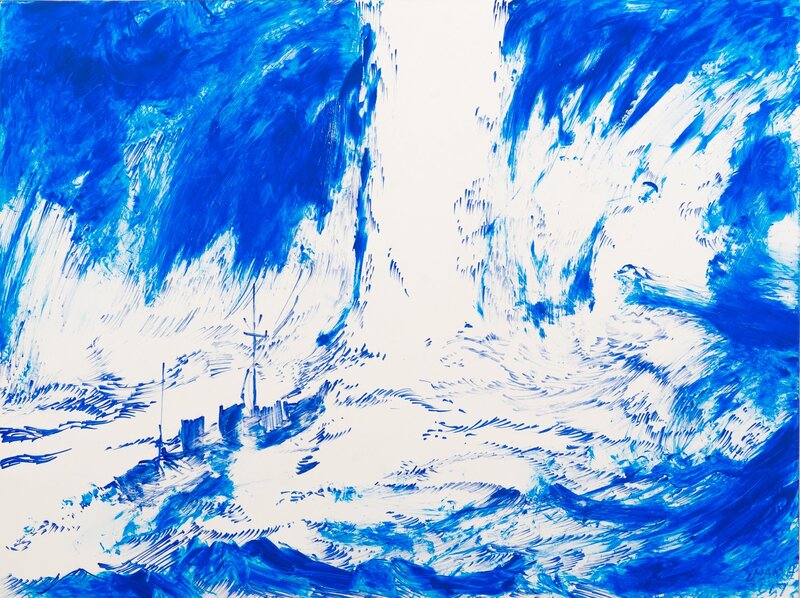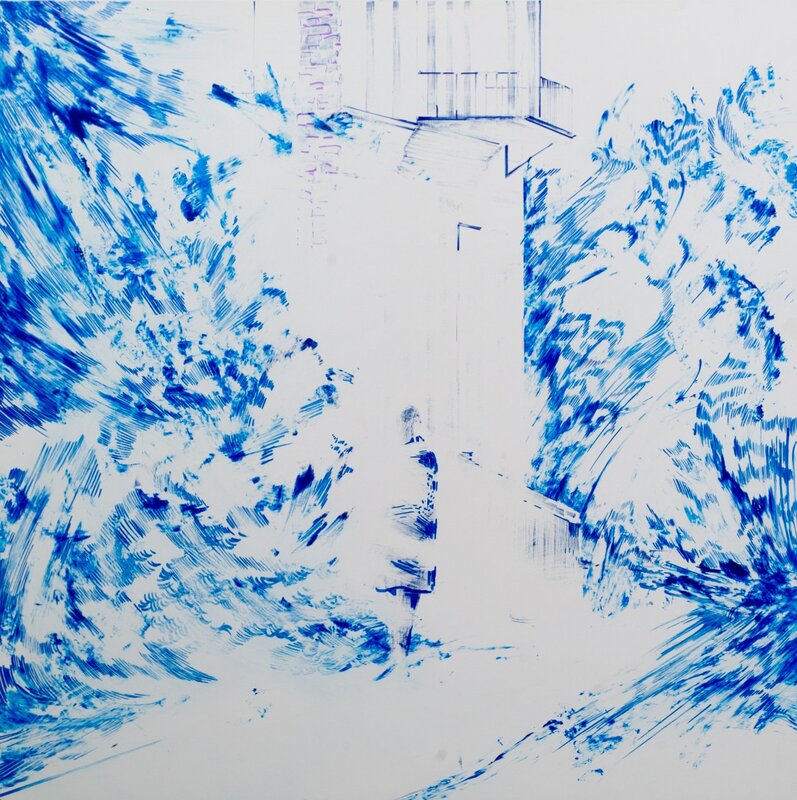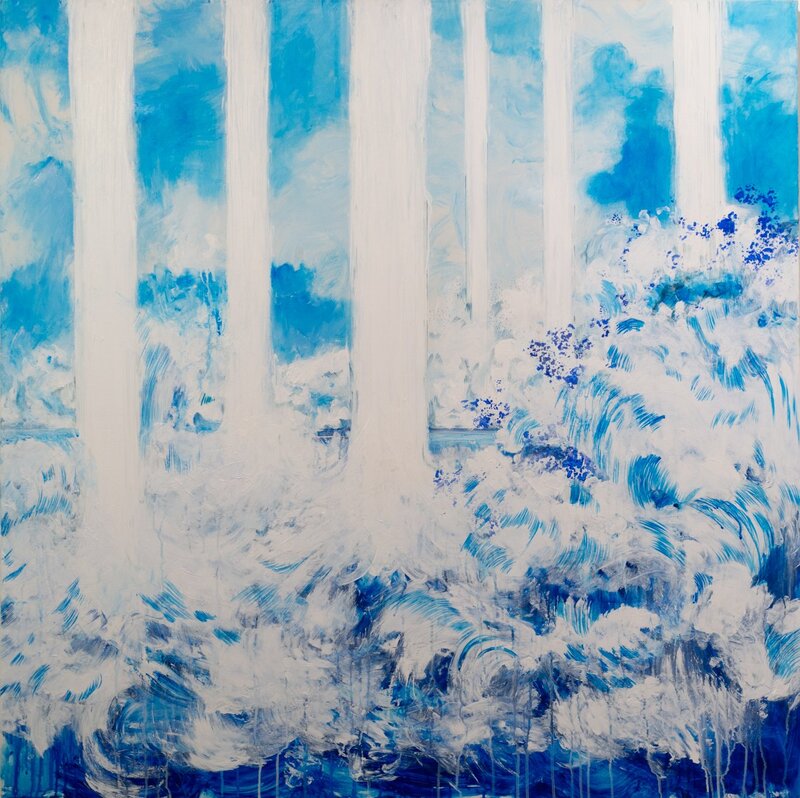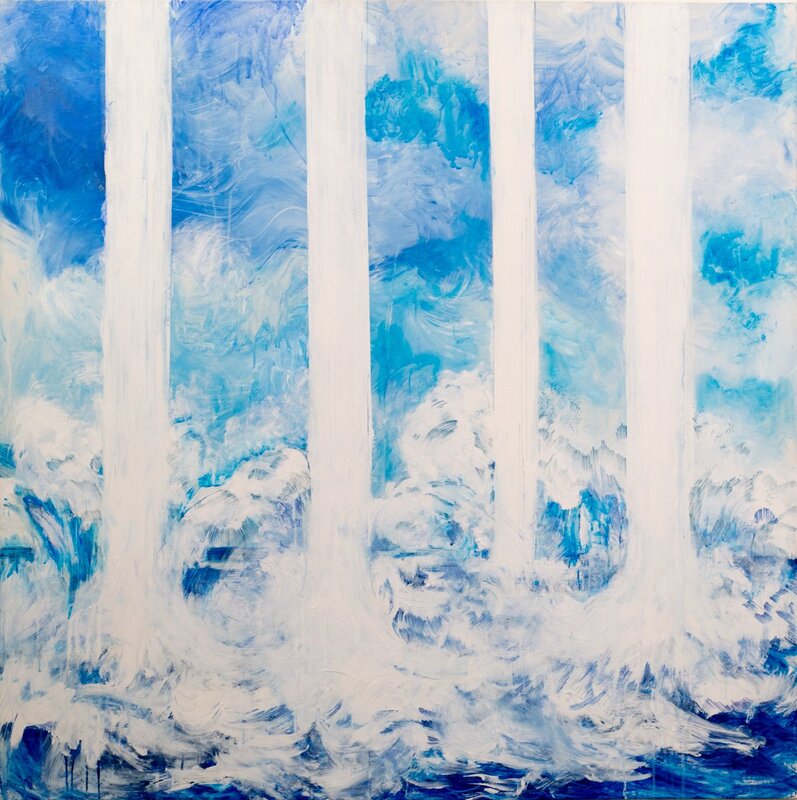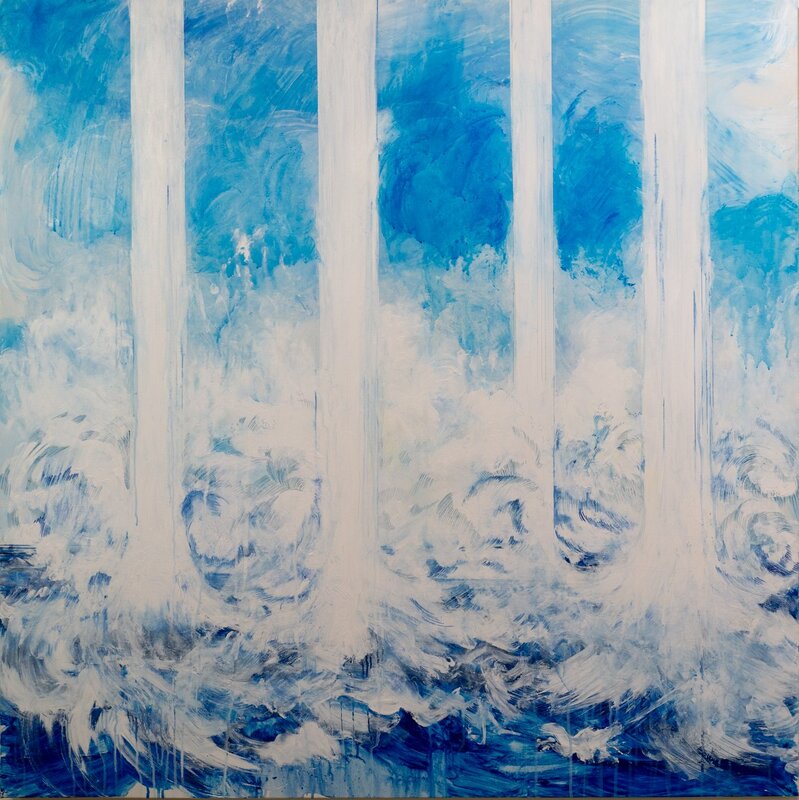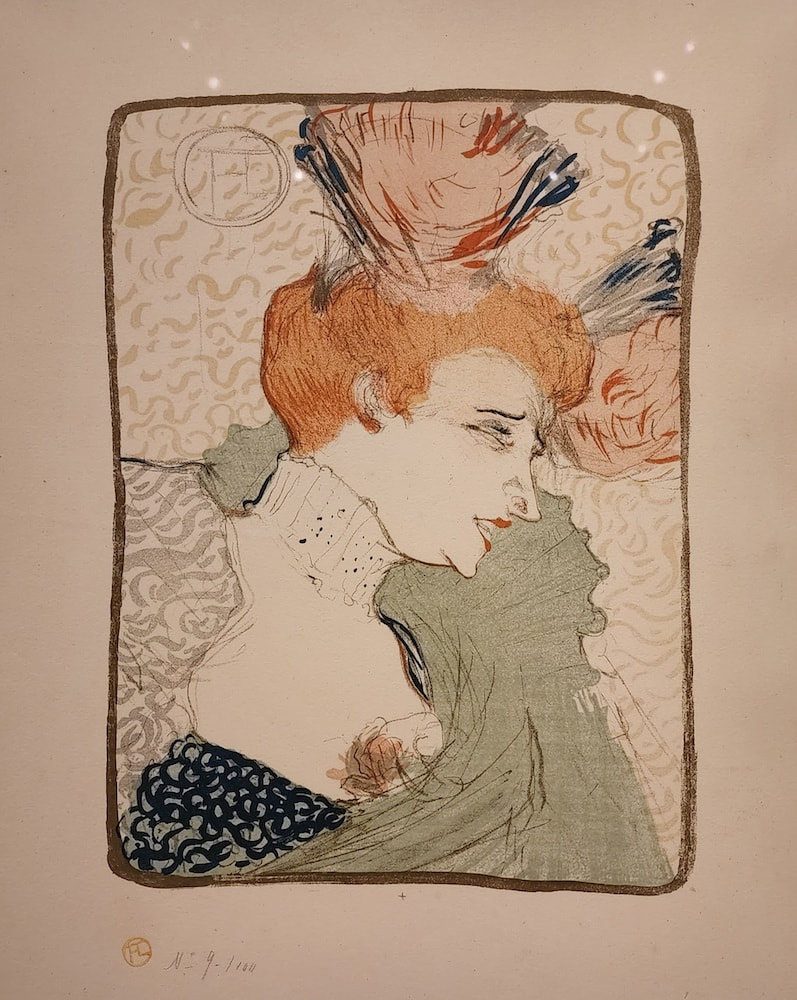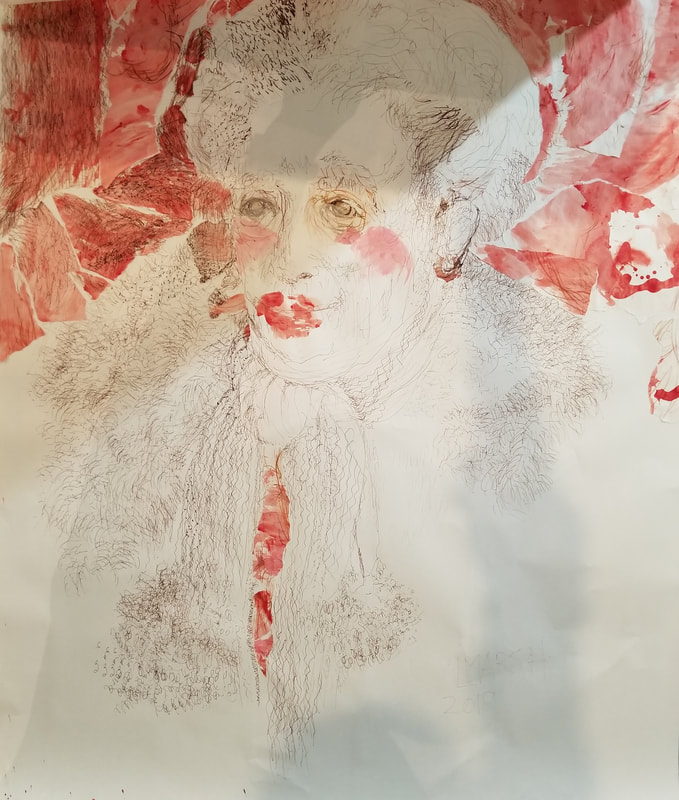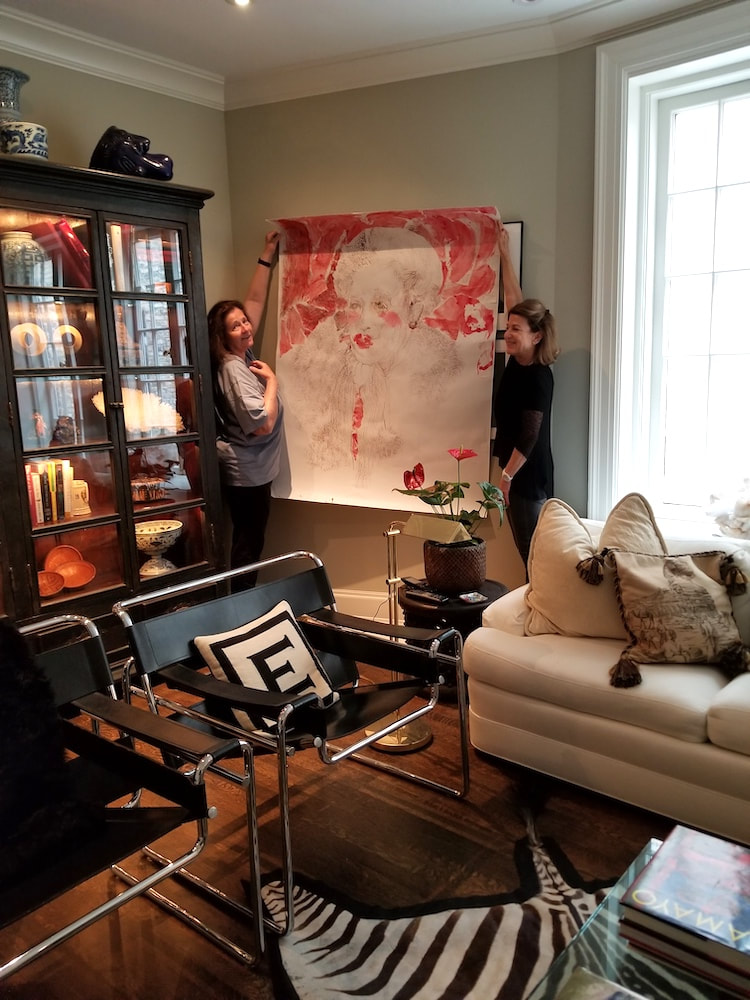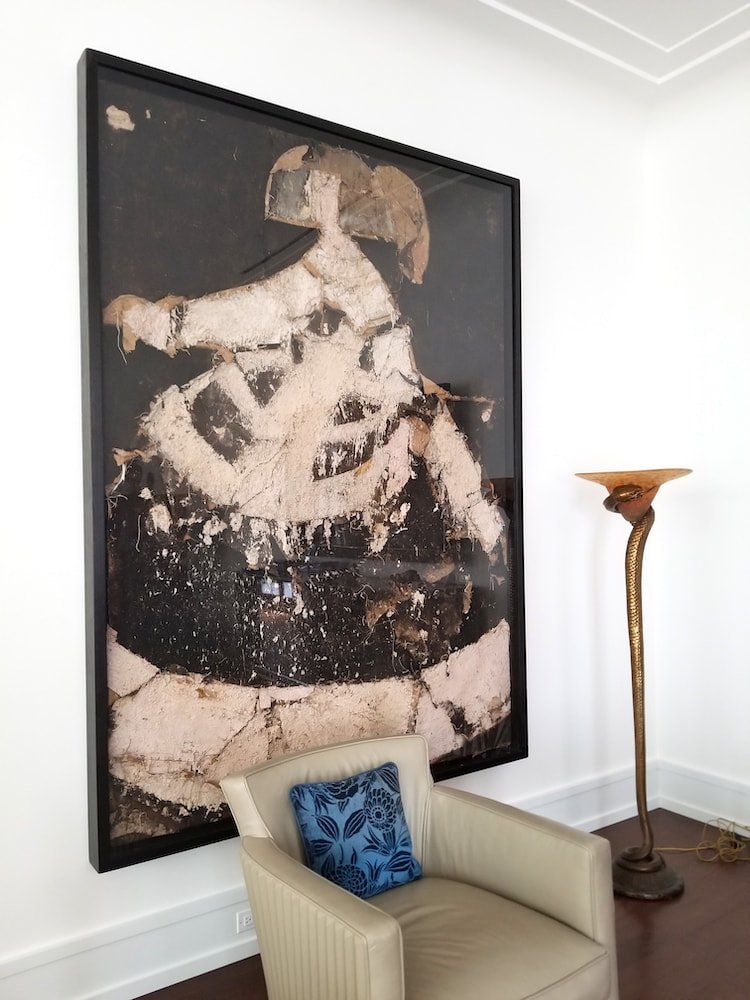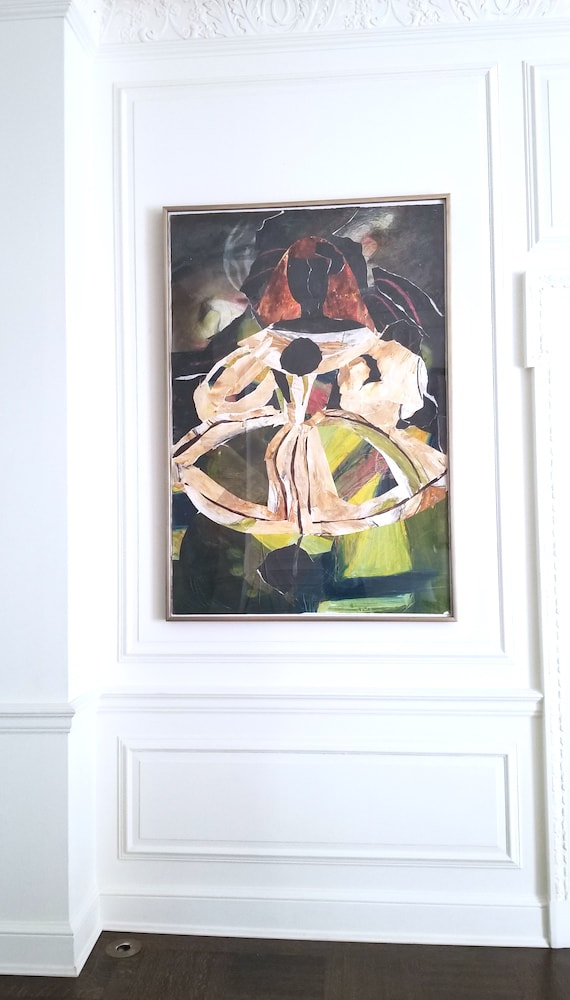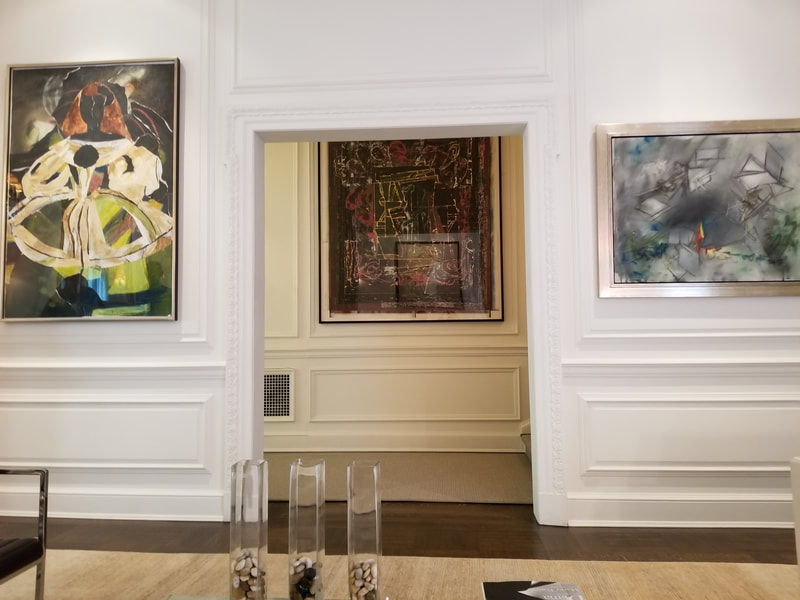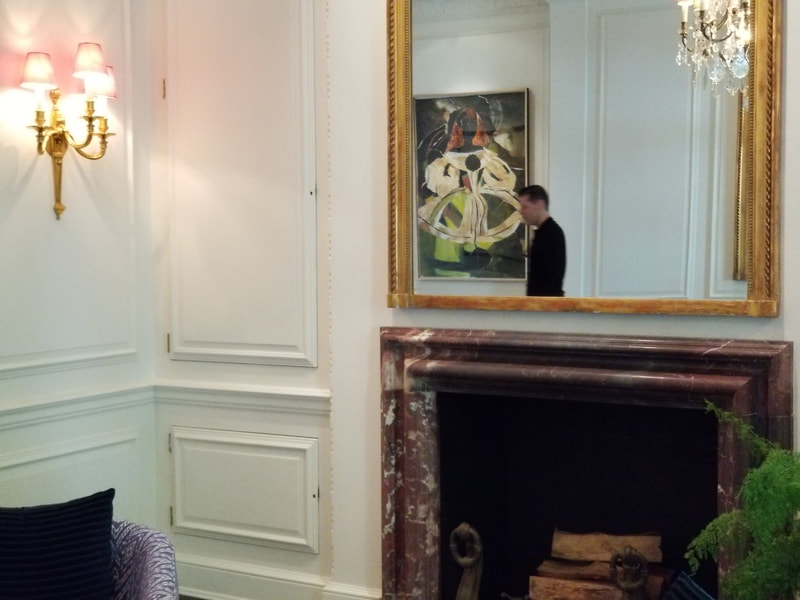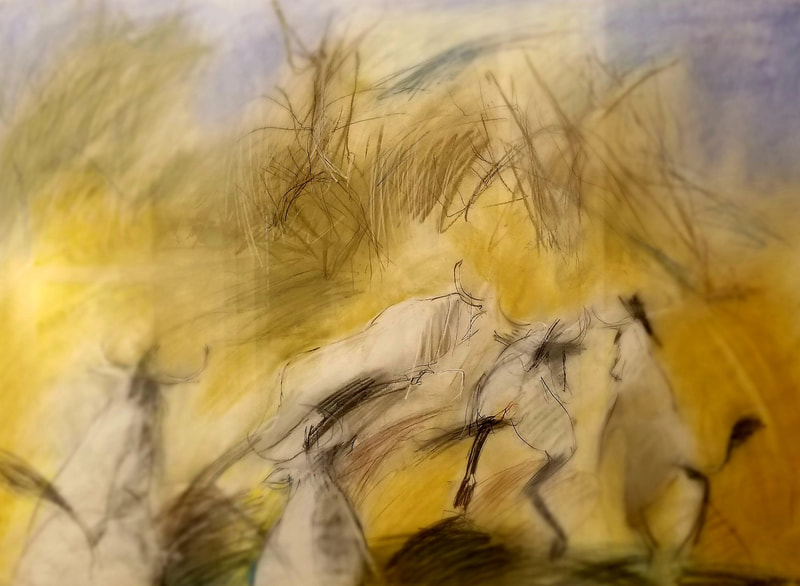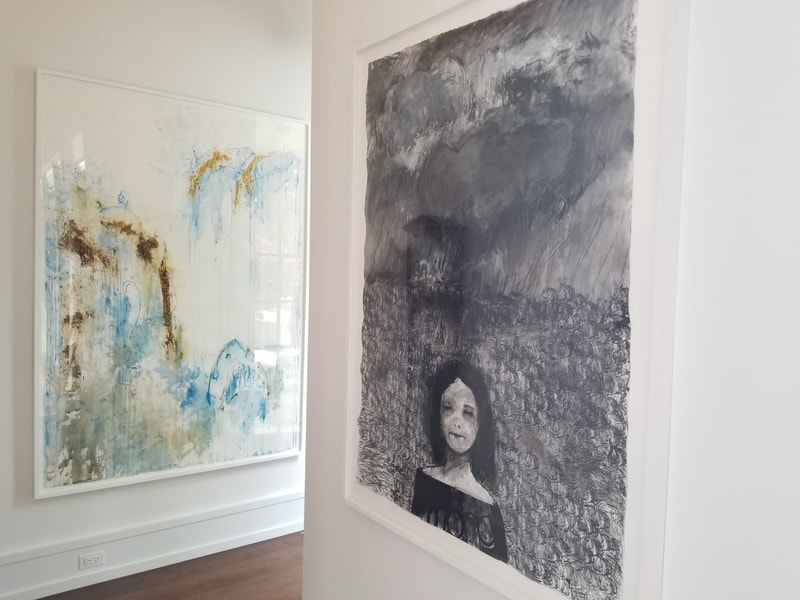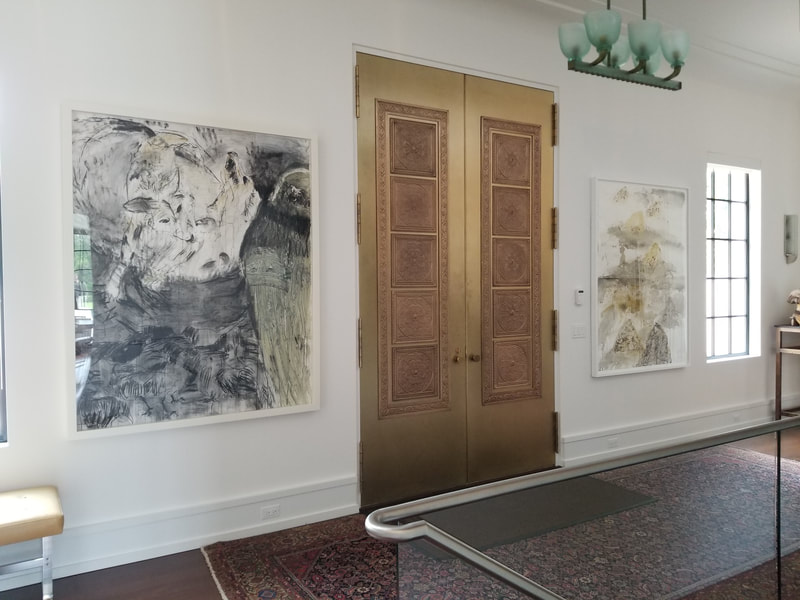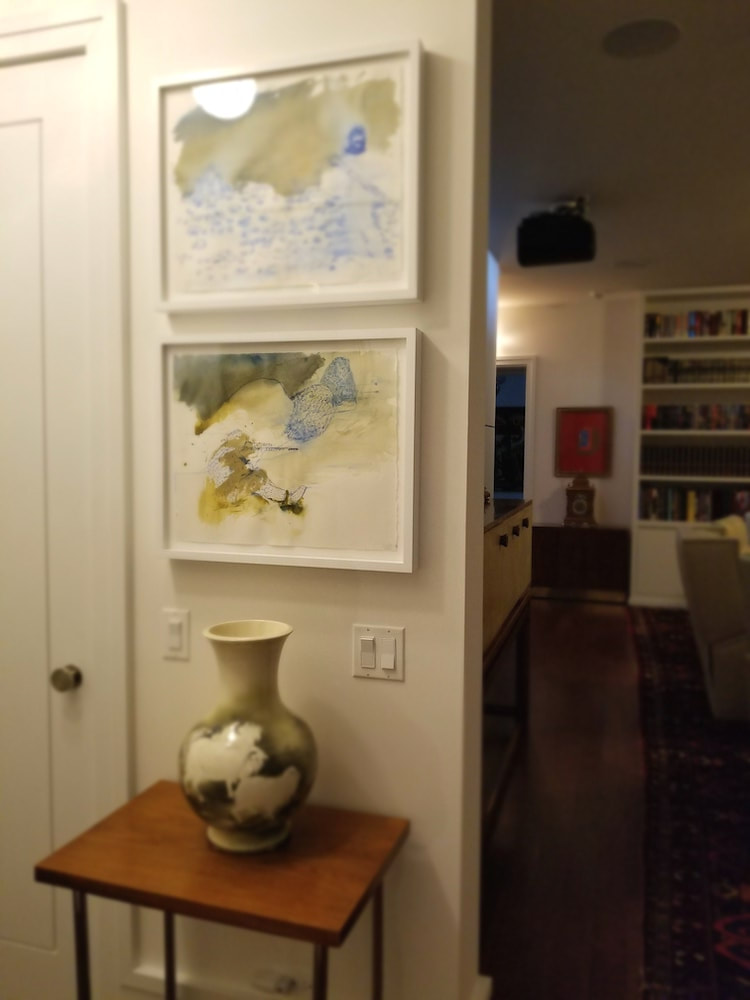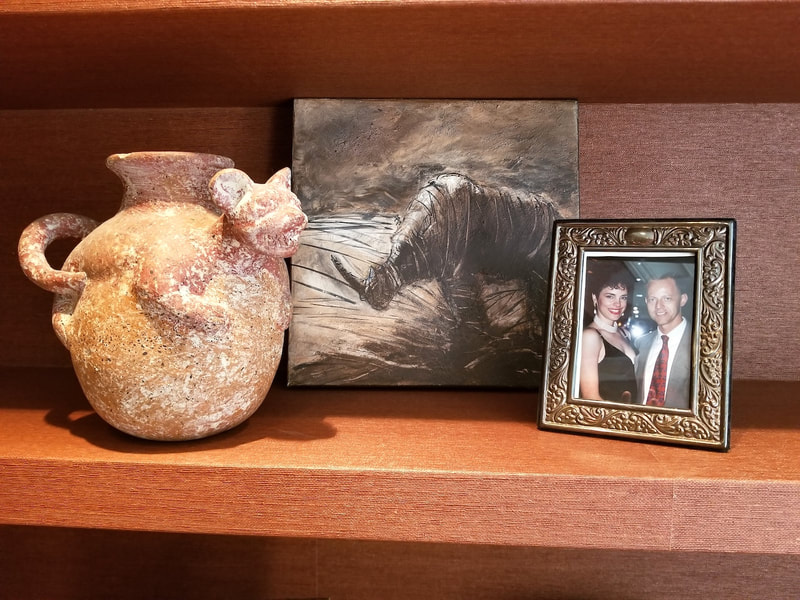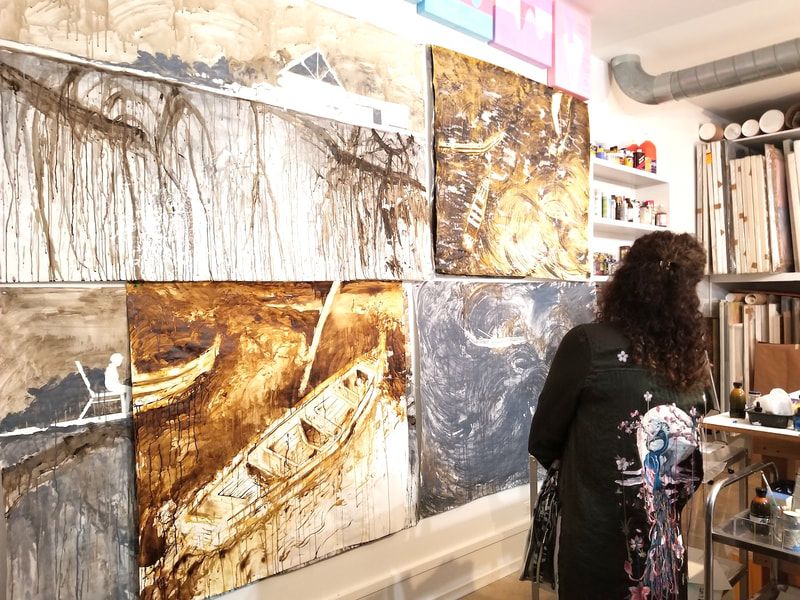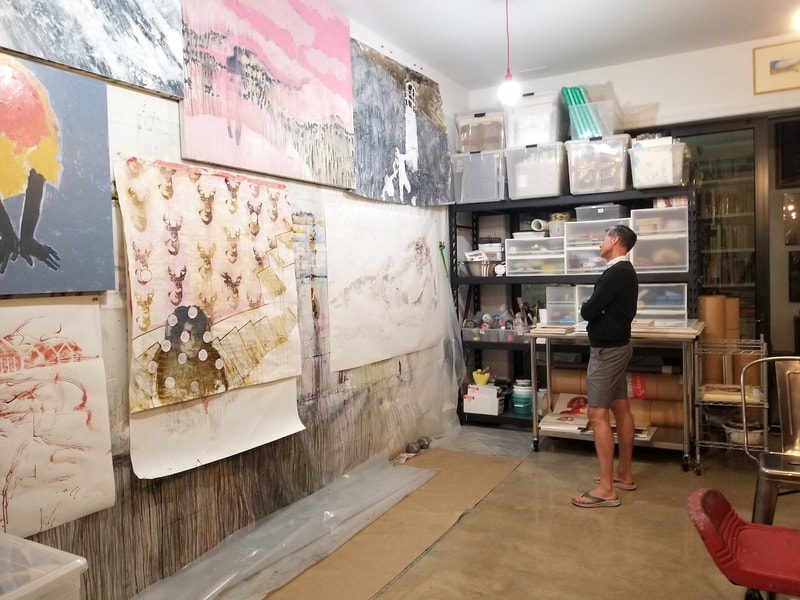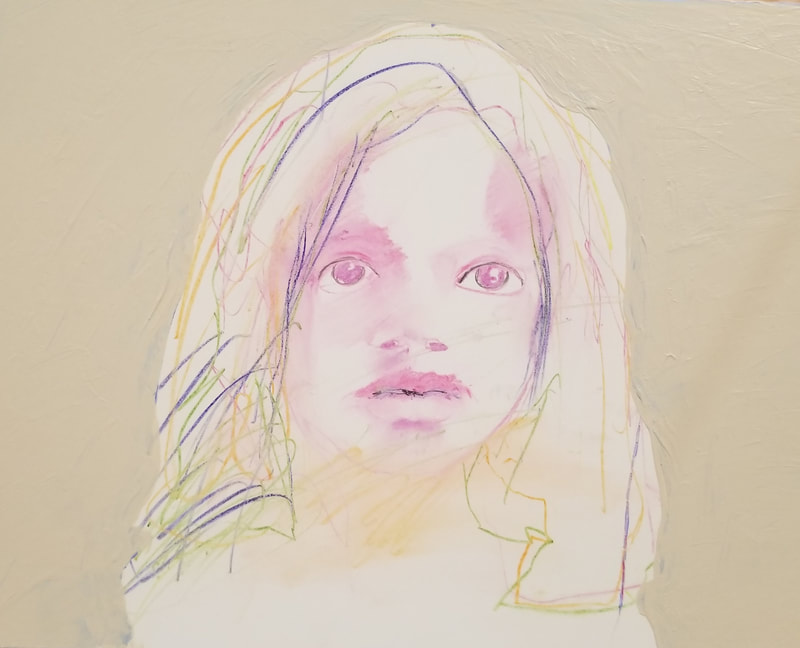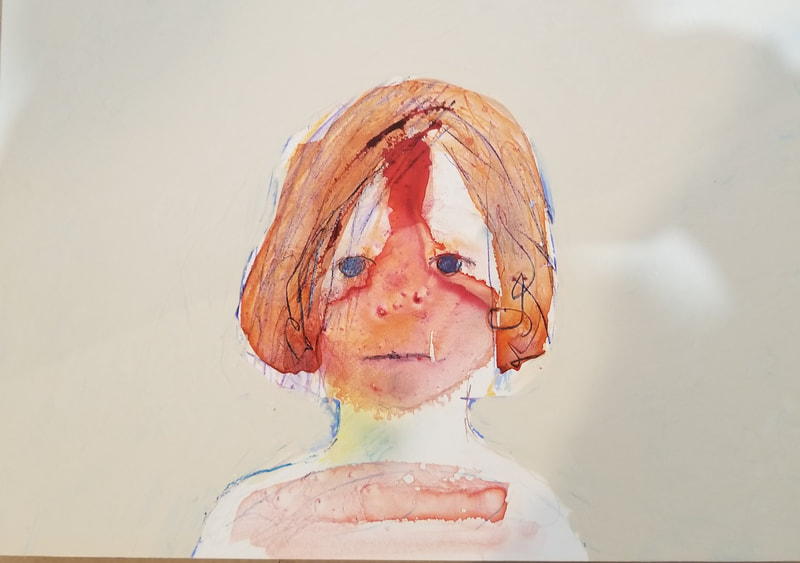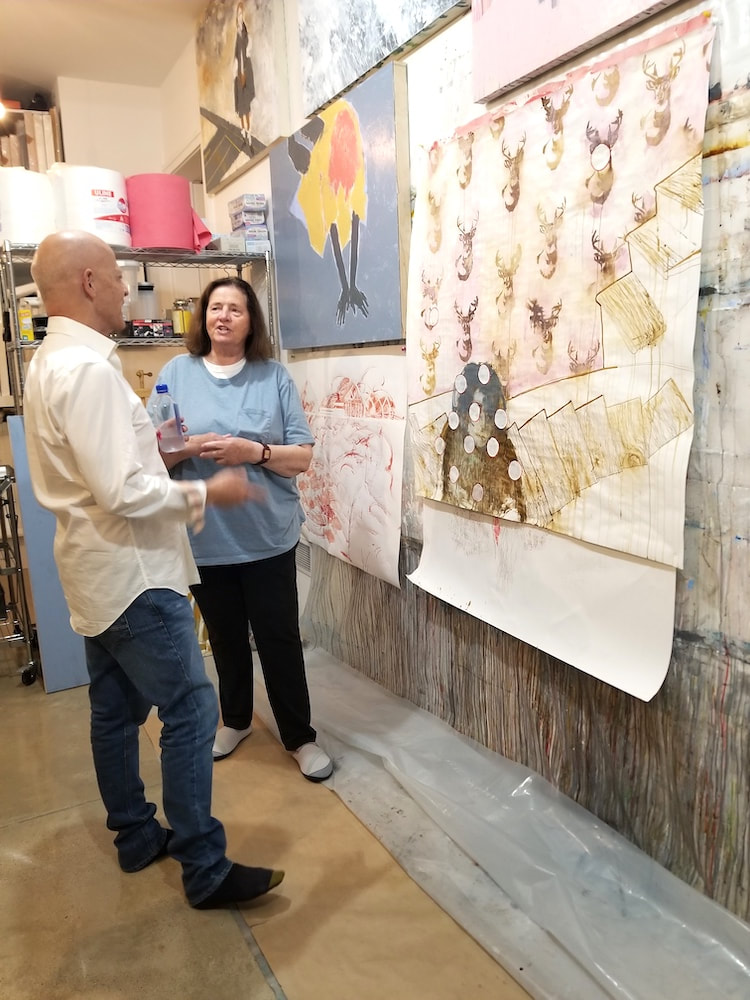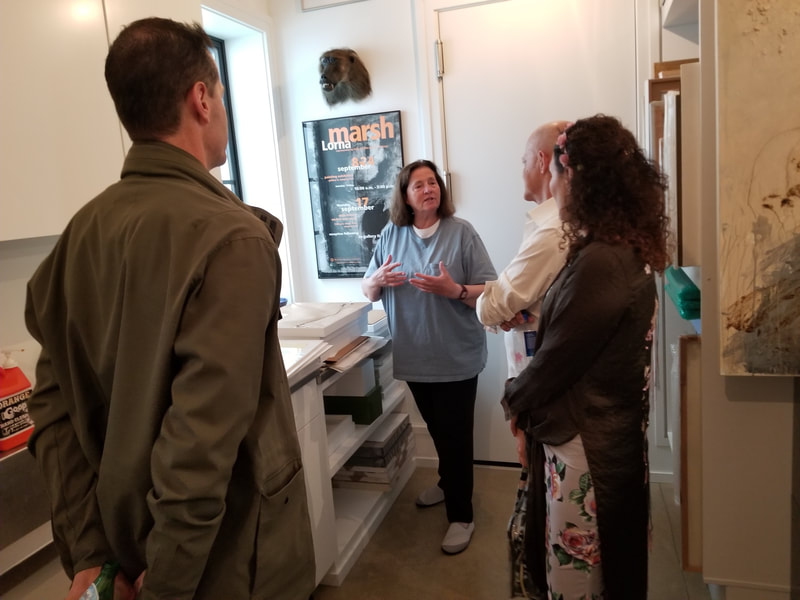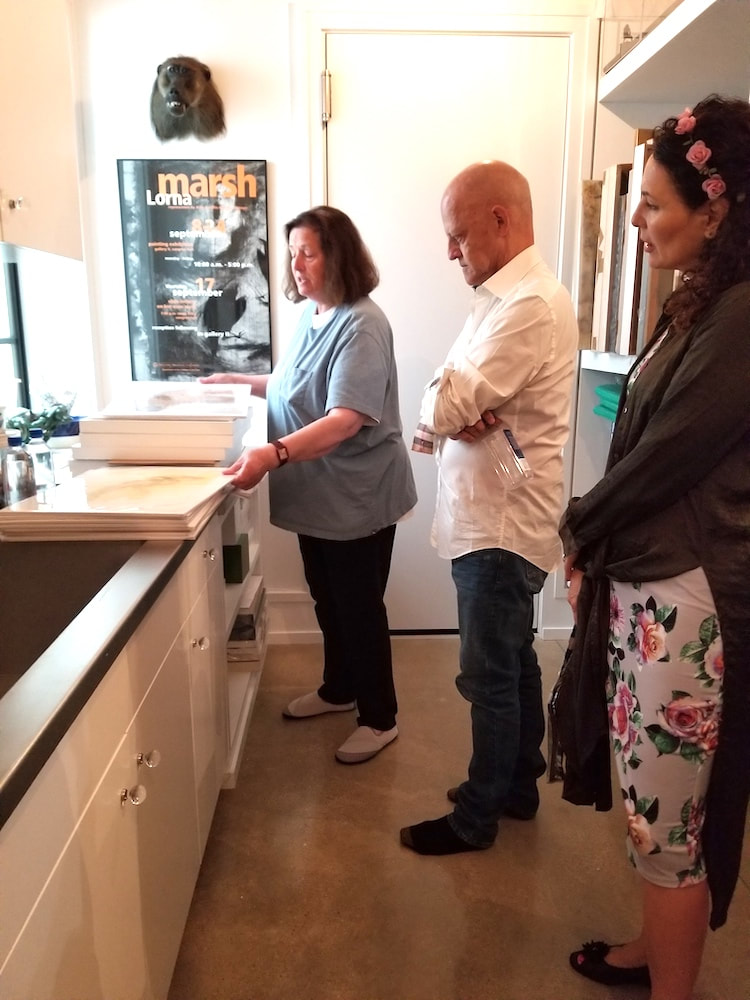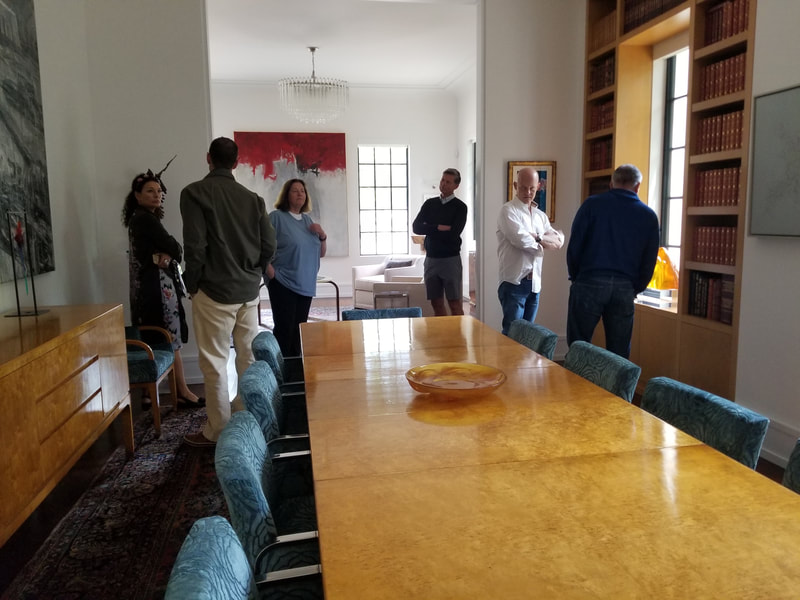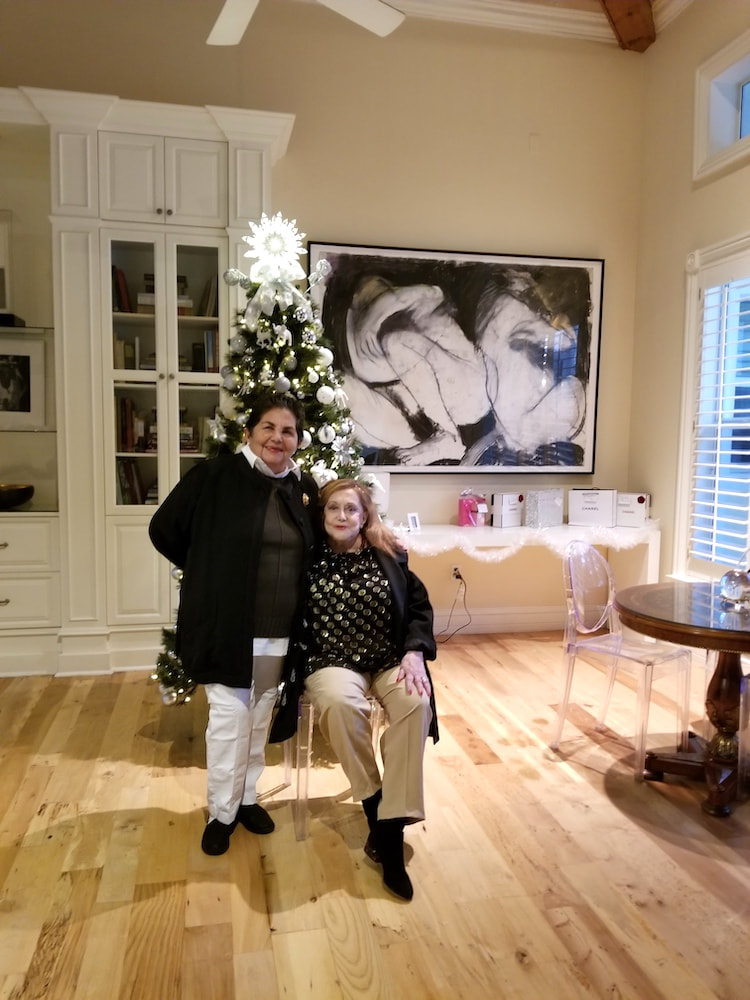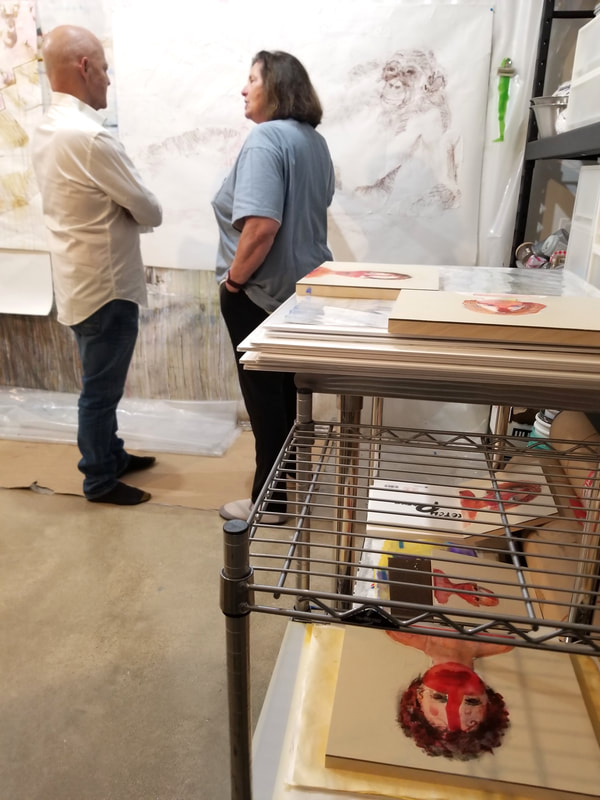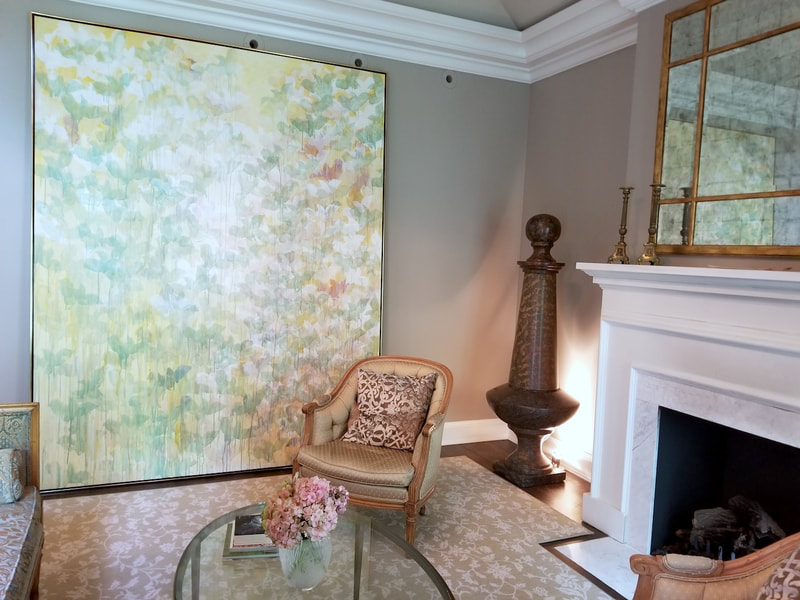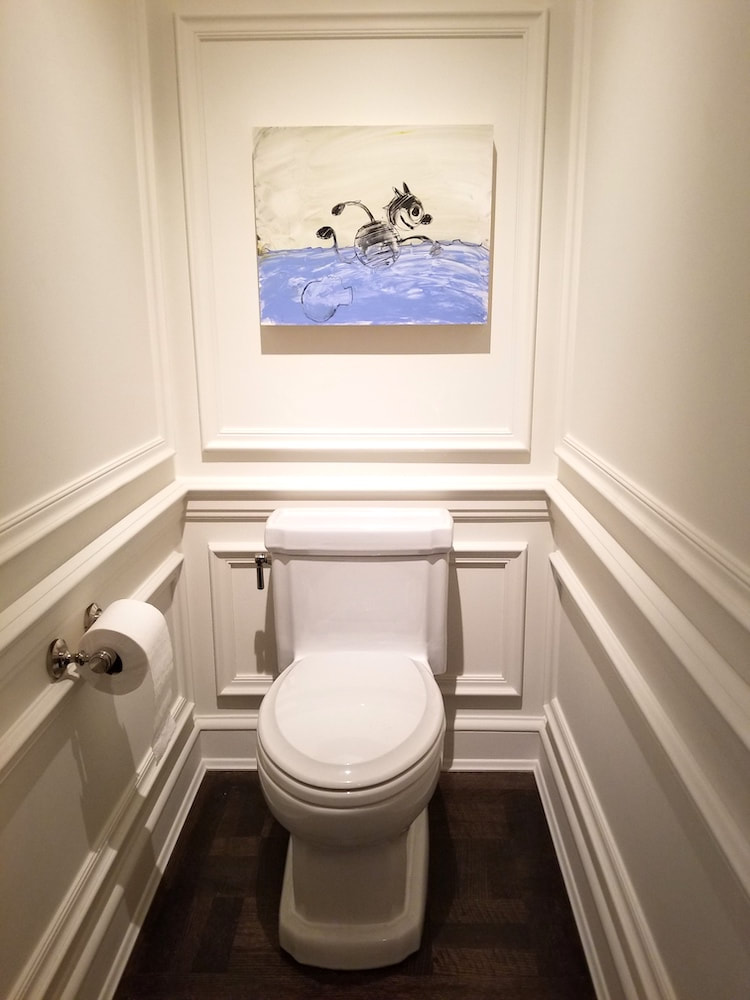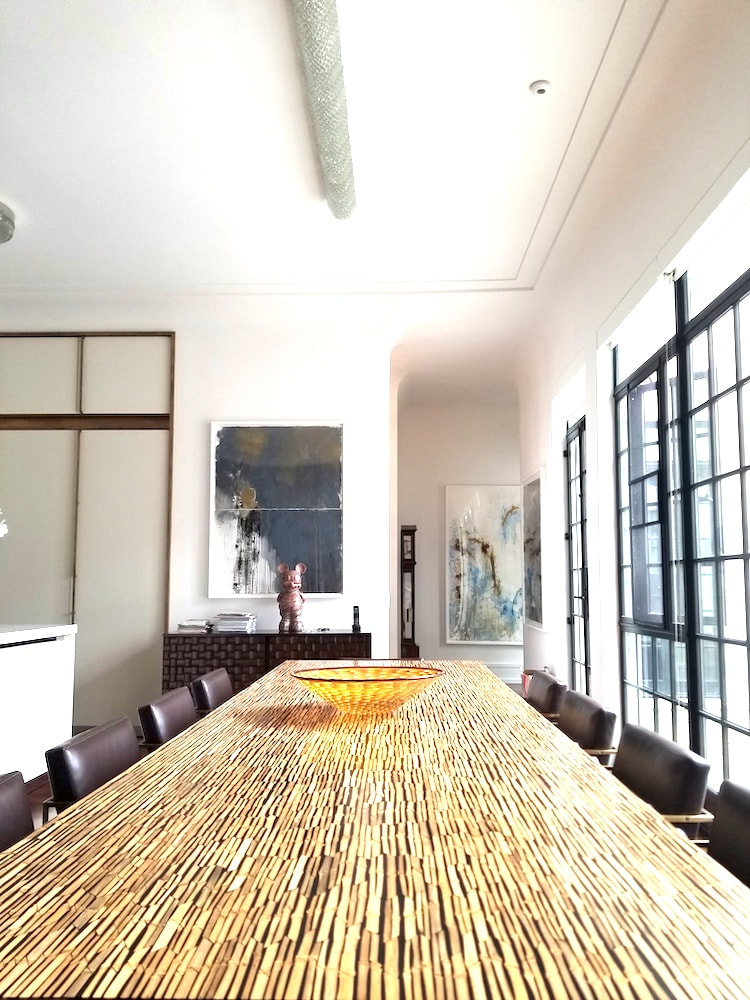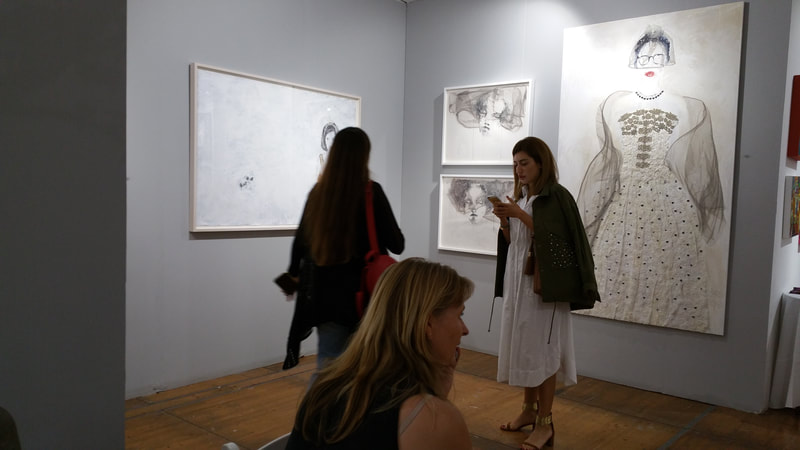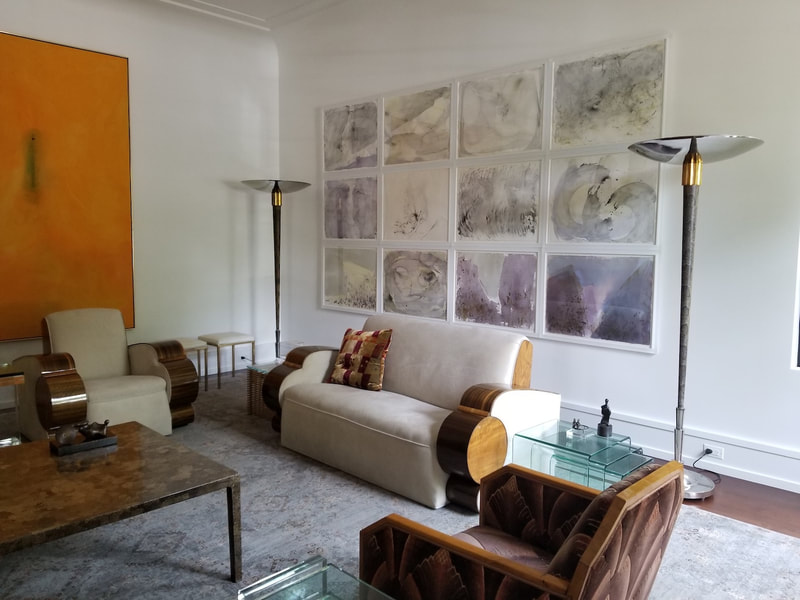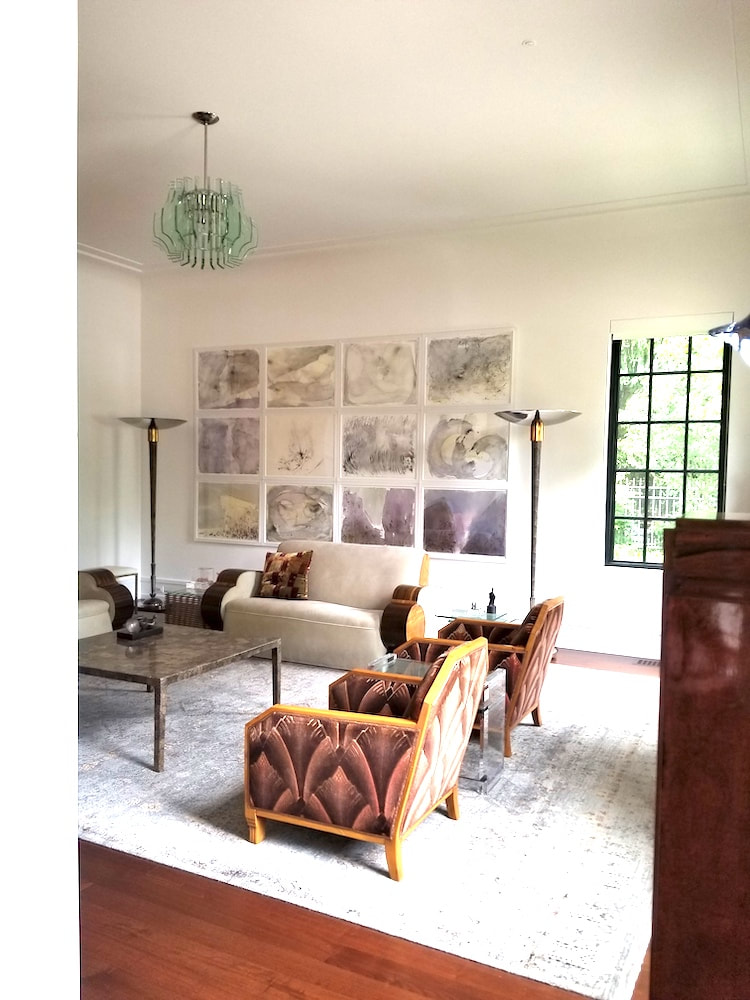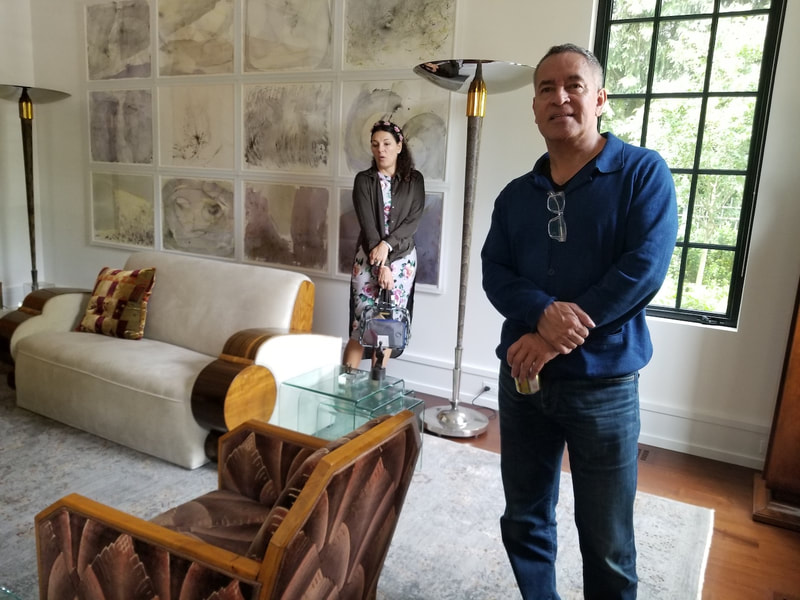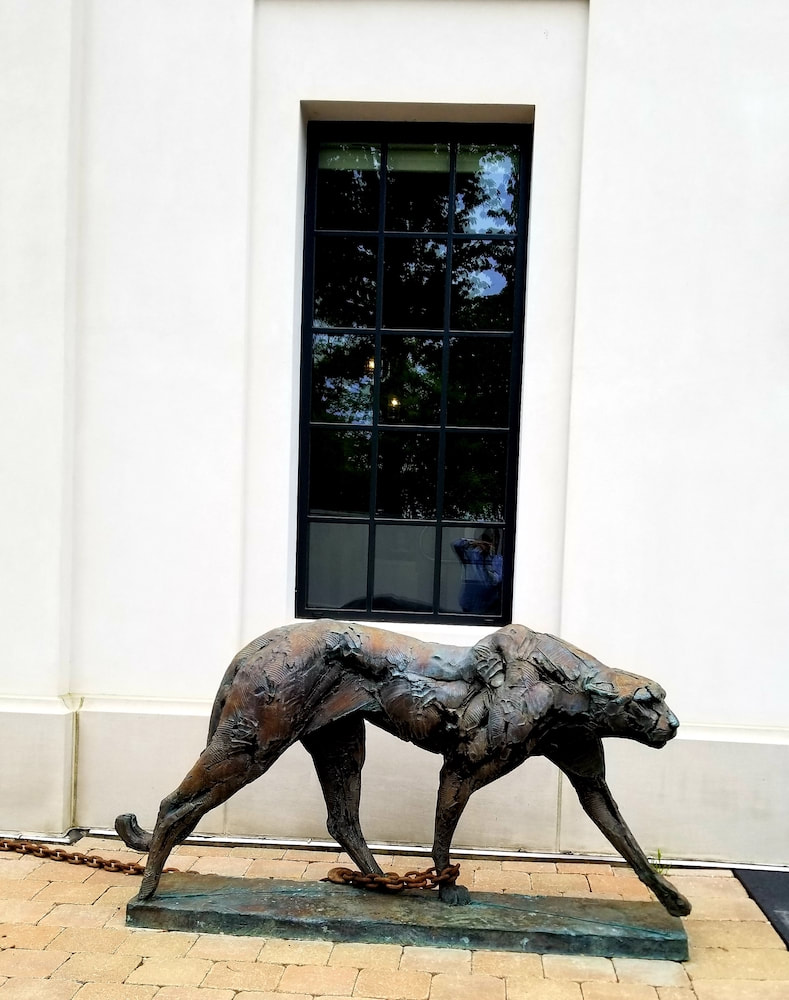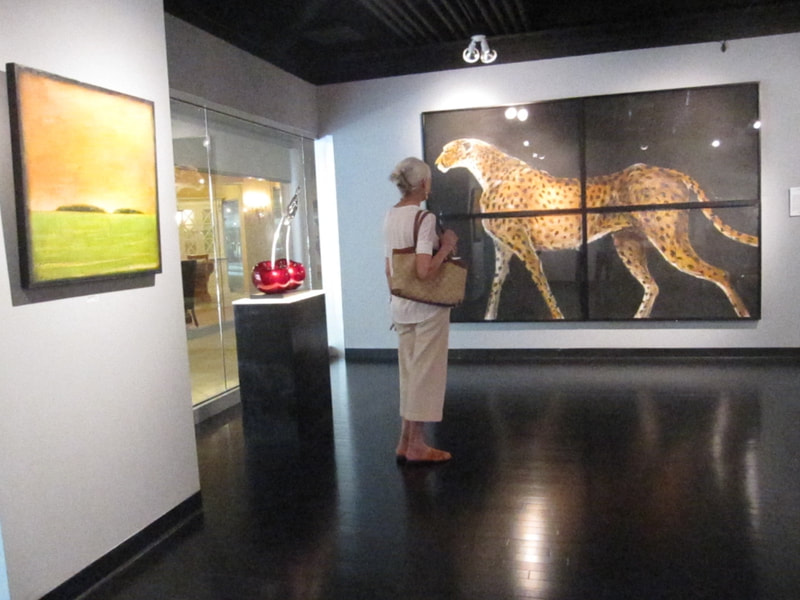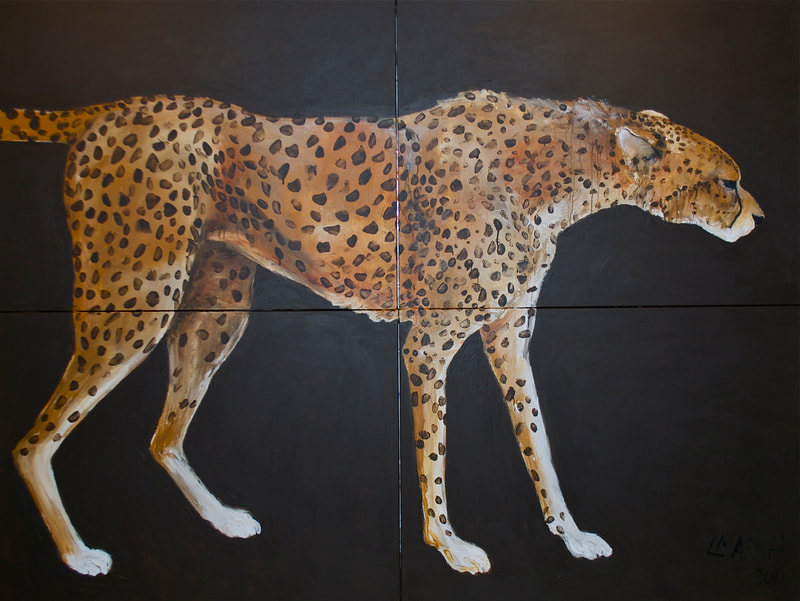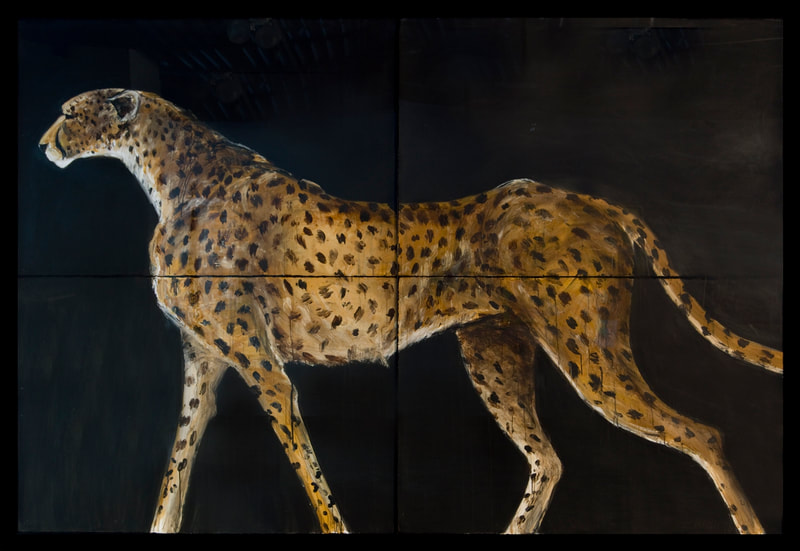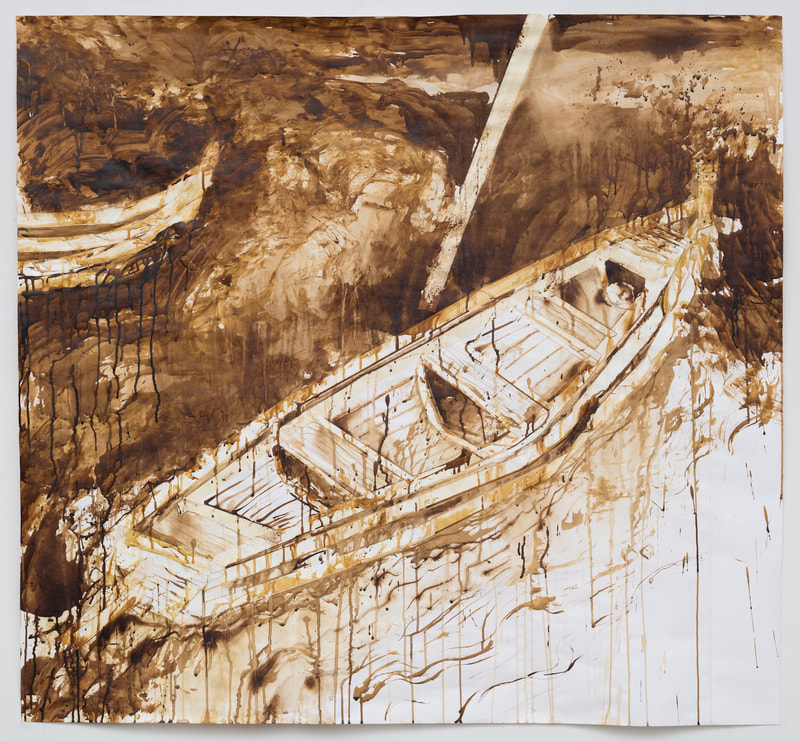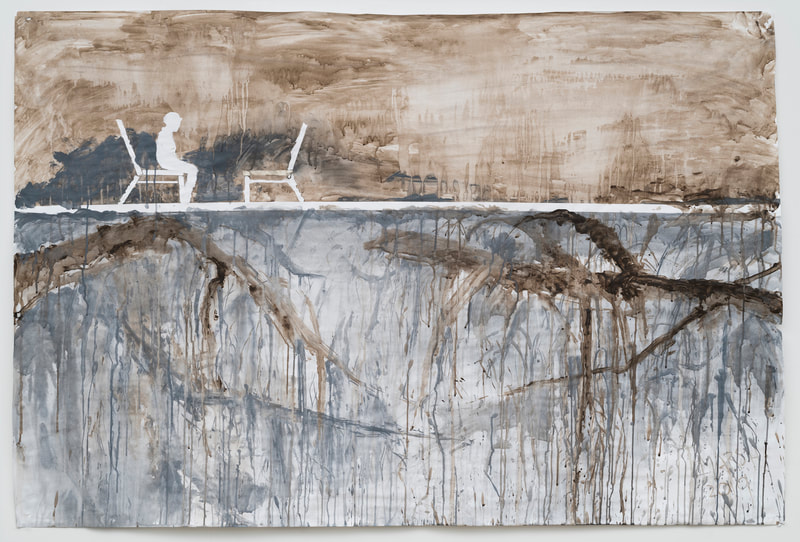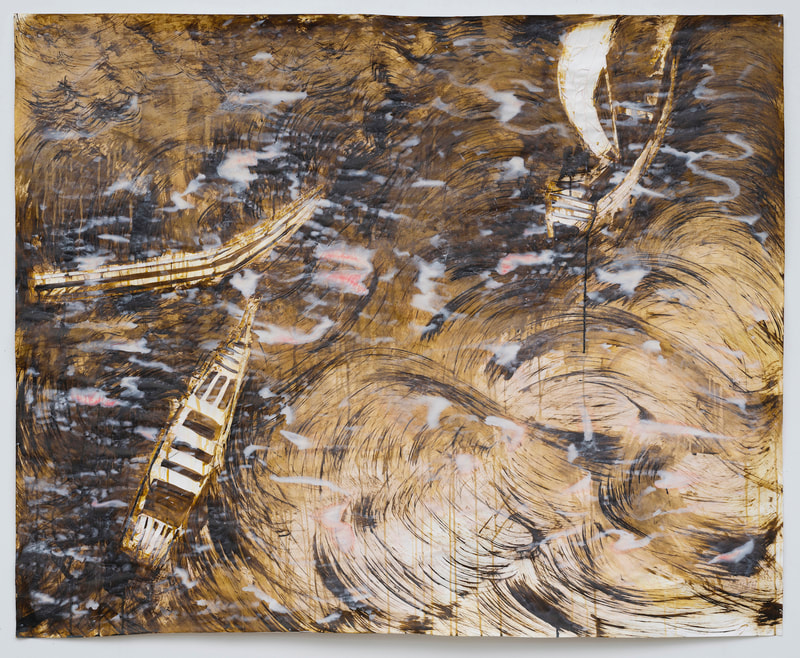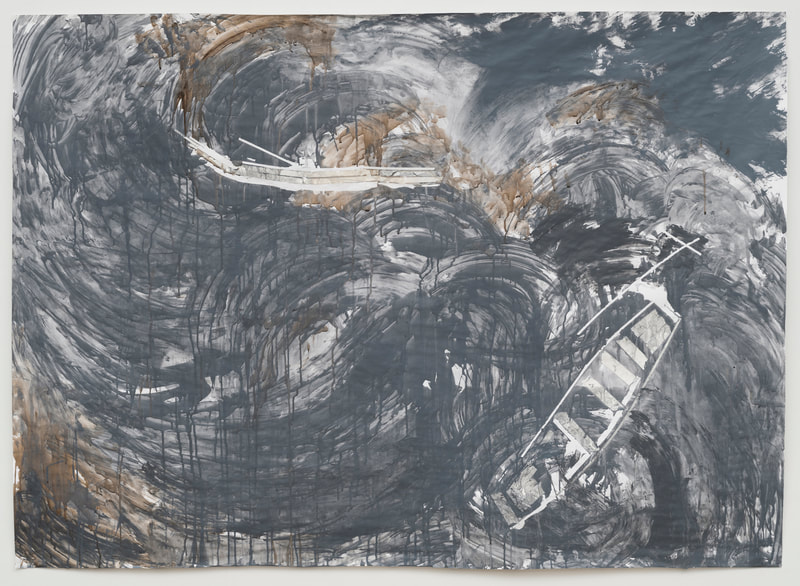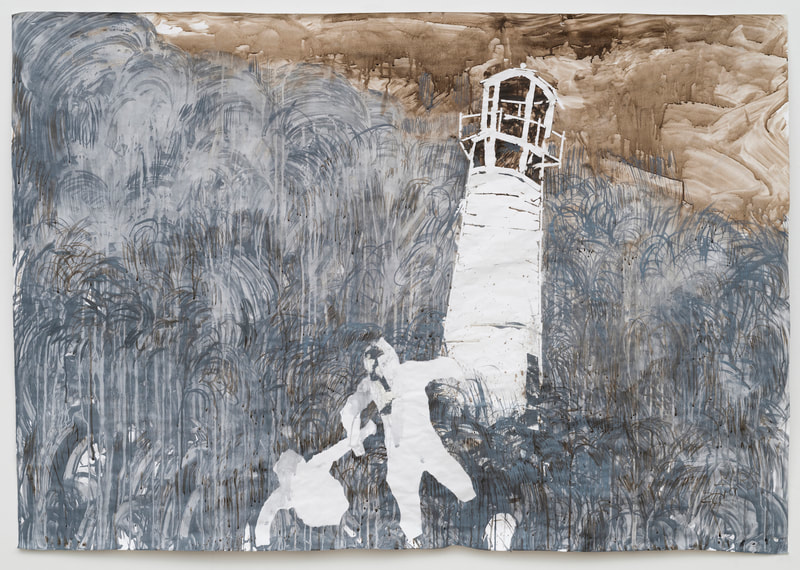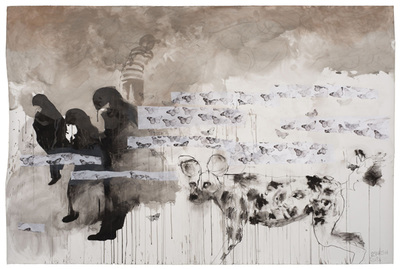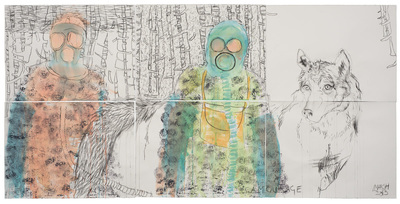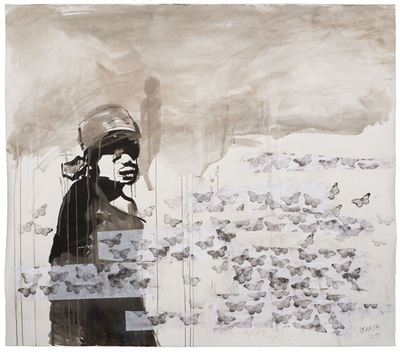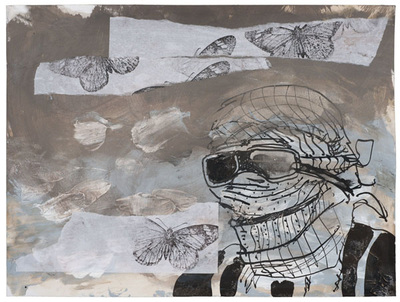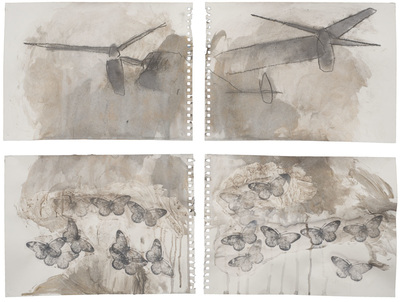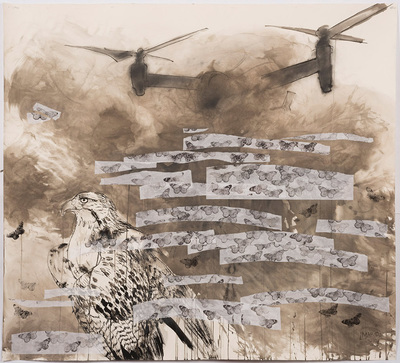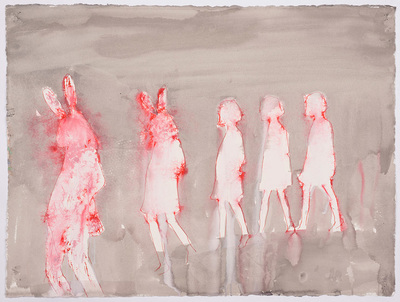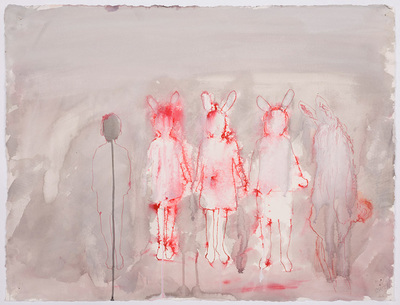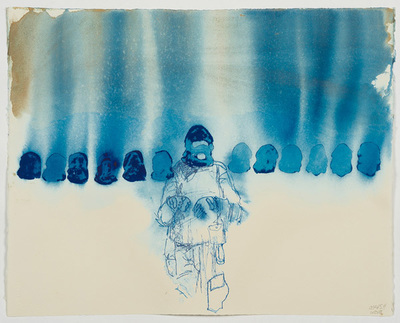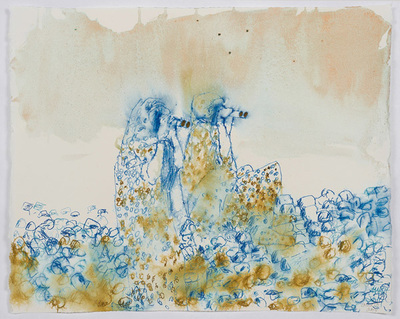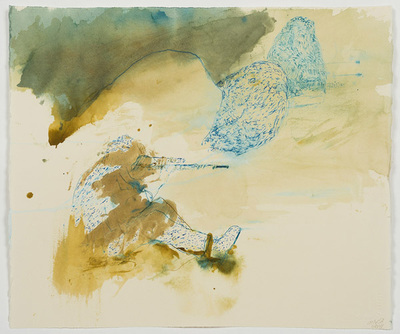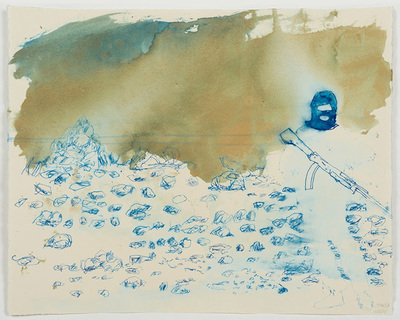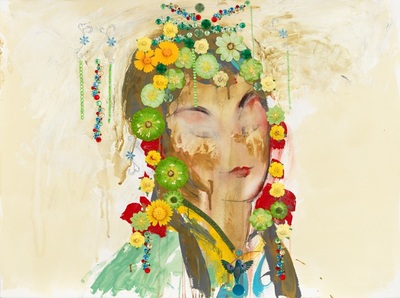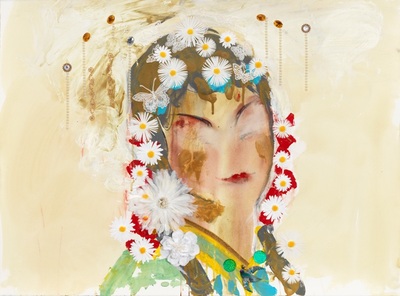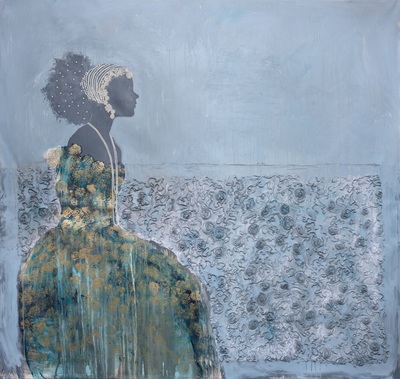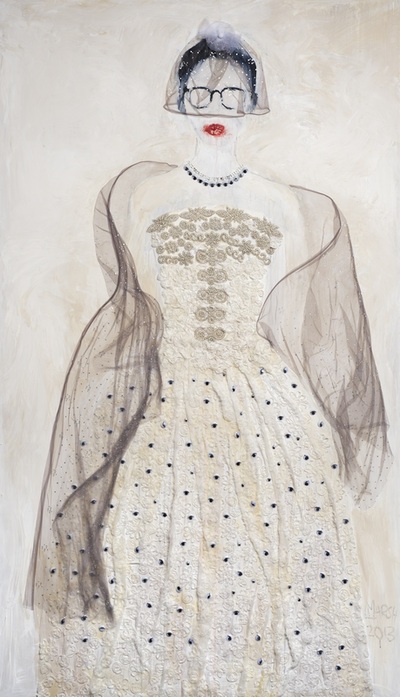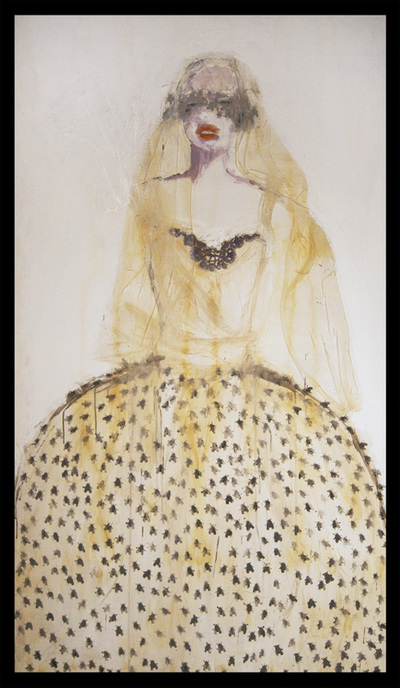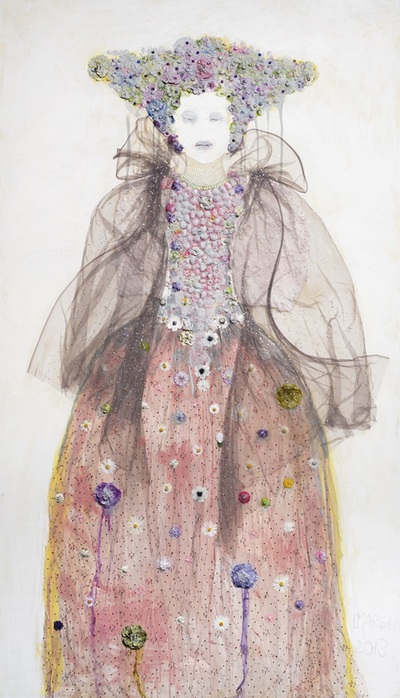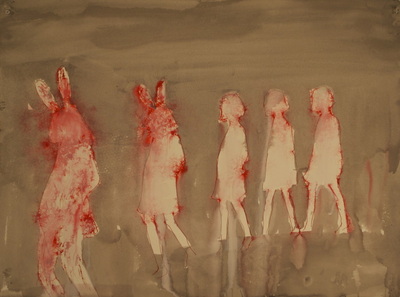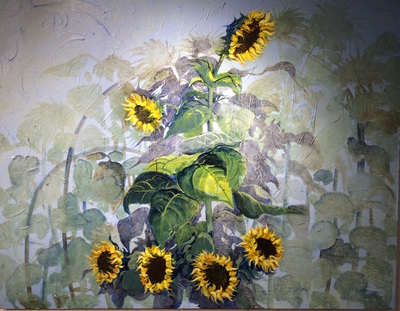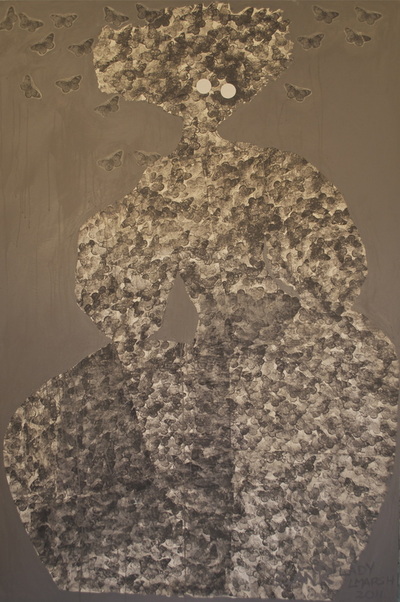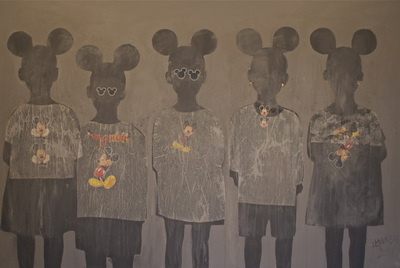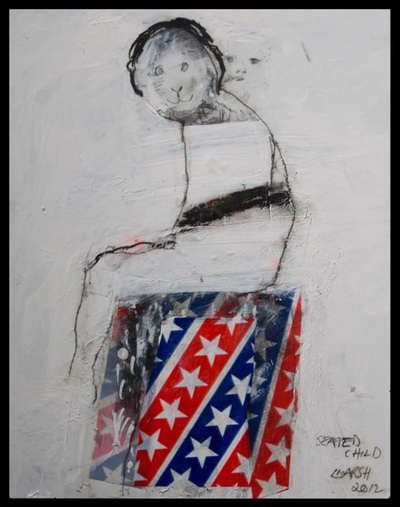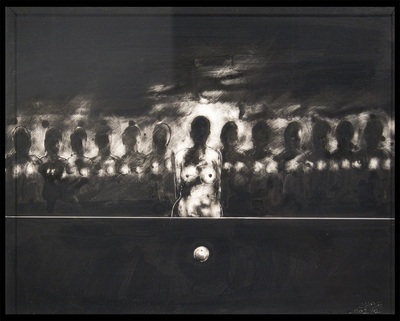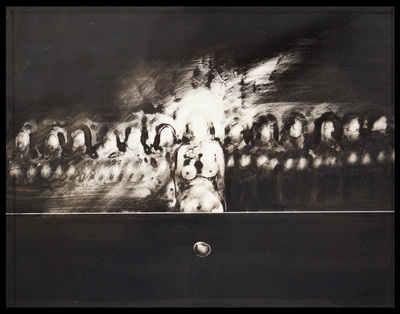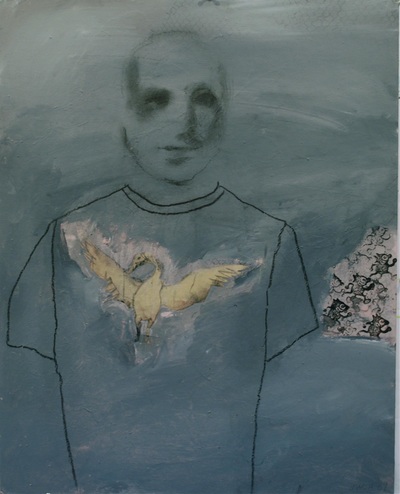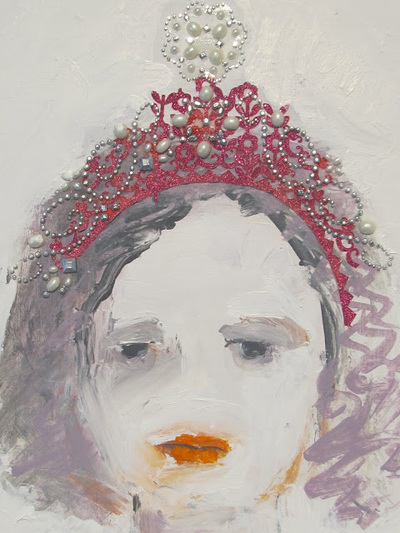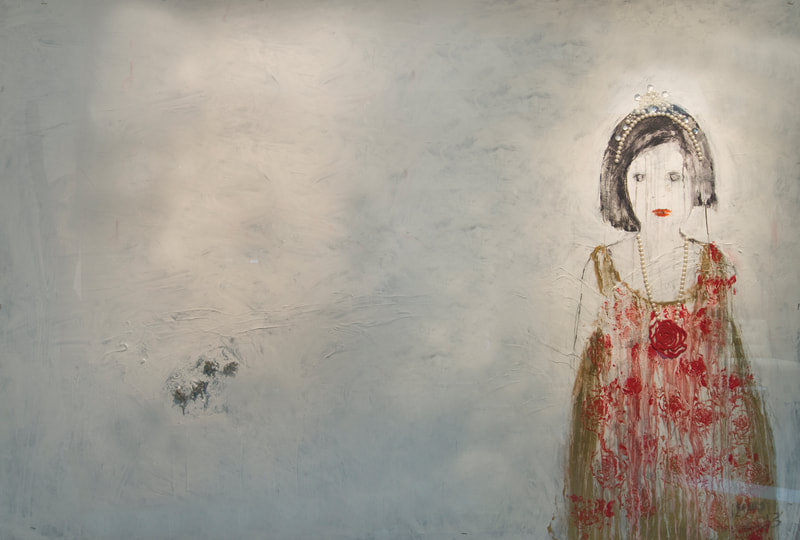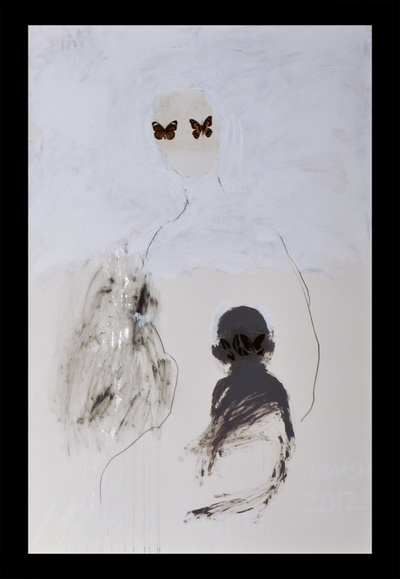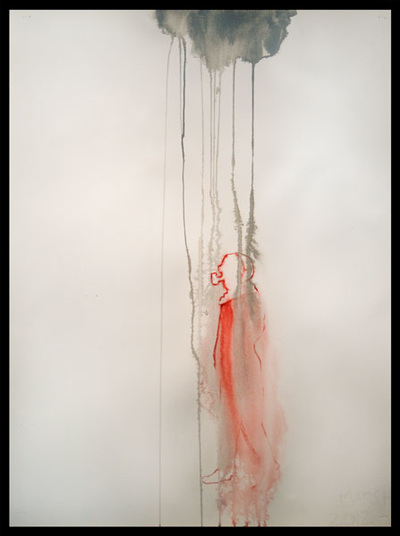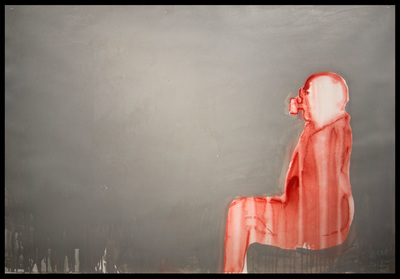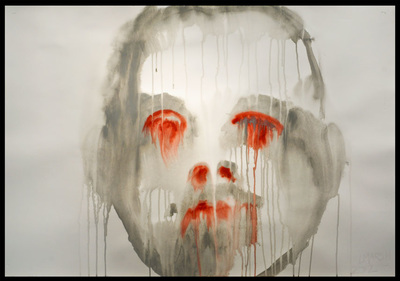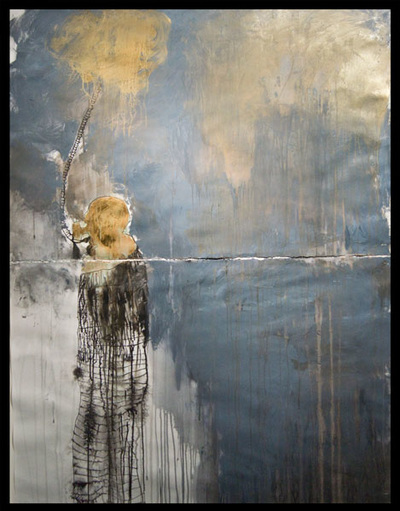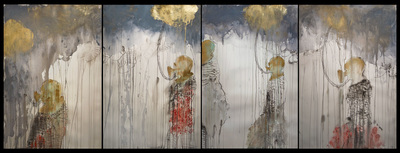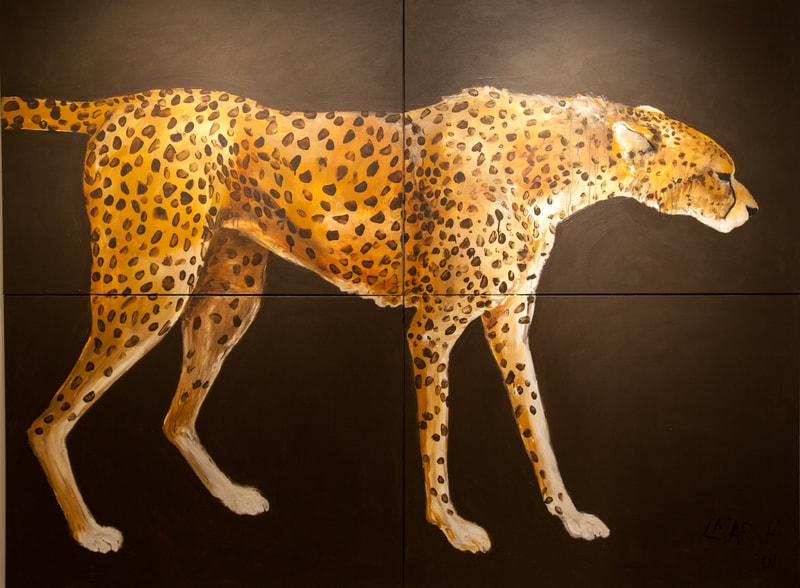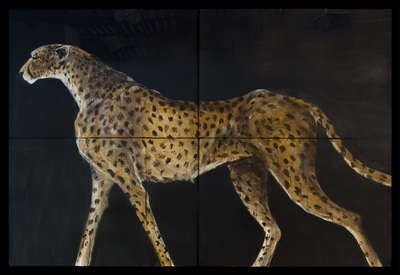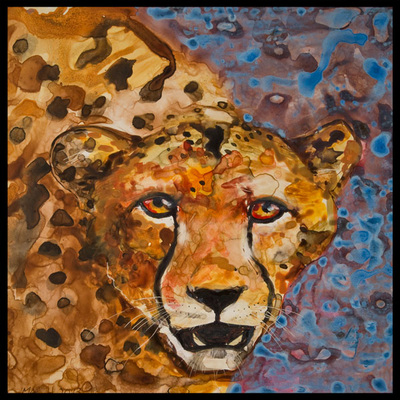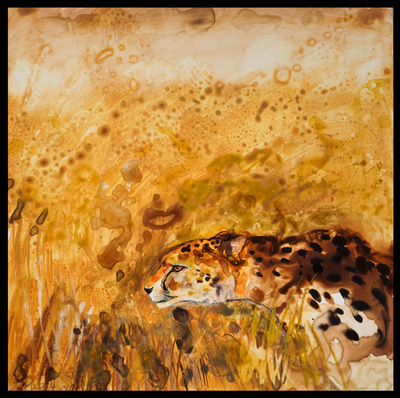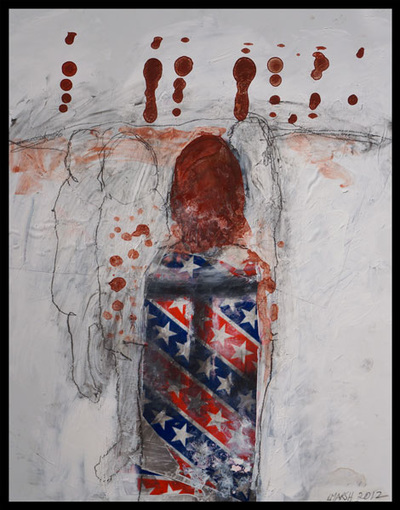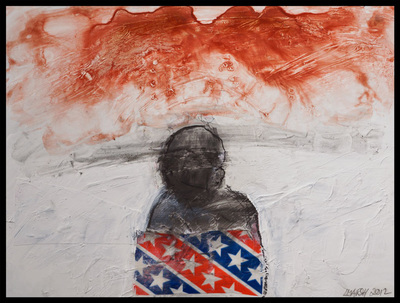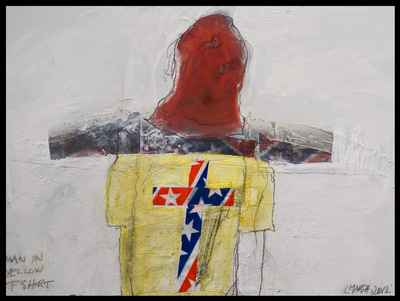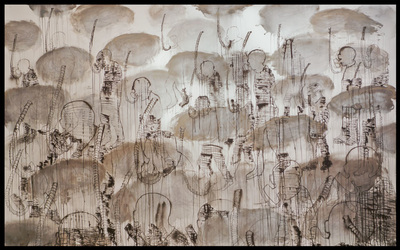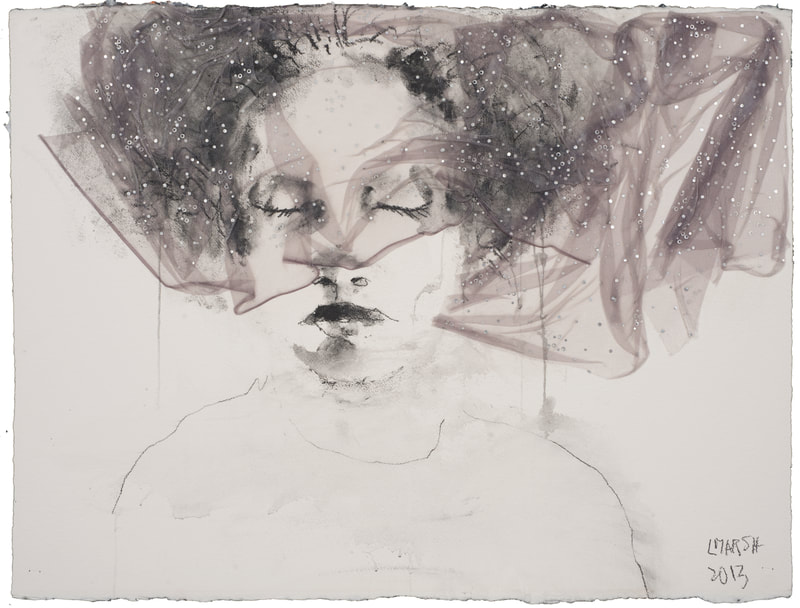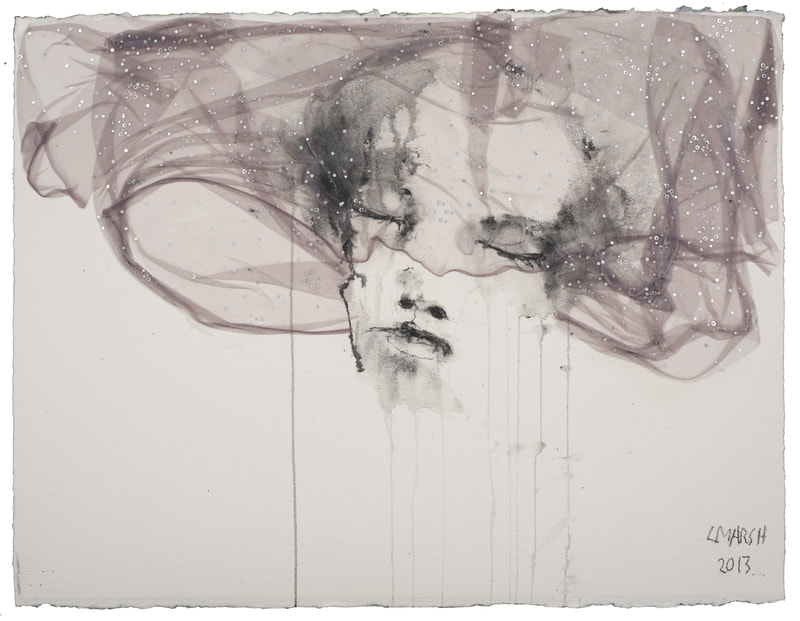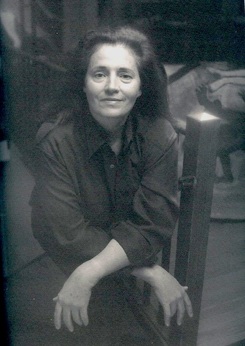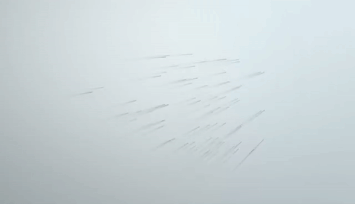LORNA MARSH
Works & Biography
Lorna Marsh, Mother and Child I, 2012, Mixed Media on Paper, 60H x 40W In.
Lorna Marsh was born in Cape Town, South Africa in 1949 (Died in 2022). Lorna Marsh is considered one of the most innovative female artists of our time. Marsh's master work often conveys dysfunctional humans with images of Africa’s large predators animals - underscoring the contrast between the dignity of nature and the self-destructive nature of man - A statement also that opposes Disney’s charming animal characters and idealistic story telling. Lorna's work also was known for never relying on repetition - each one of her series were new and distinct.
Lorna Marsh presence, like her canvases, was larger than life. In her youth she was a stage actress and model.
Lorna Marsh, Portrait of a Lady I, Mixed media on Canvas, 48 x 48 In.
Lorna Marsh was a keen thinker and delighted in testing boundaries, which she reflected in her art. Internationally celebrated, her works were often confrontational and explored such themes as mankind’s destructive relationship with nature. Her painting of a lion's head on a stake planted in a scorched landscape comes to mind. - Lorna Marsh, Kudu Carcass, 1996, Mixed Media on Paper, 22 x 30 In.
LORNA MARSH WILDLIFE
LORNA MARSH FEMALE FIGURE
Lorna Marsh, American Child, 2012, Mixed Media on Paper, 60 x 40.5 In.
LORNA MARSH LANDSCAPES
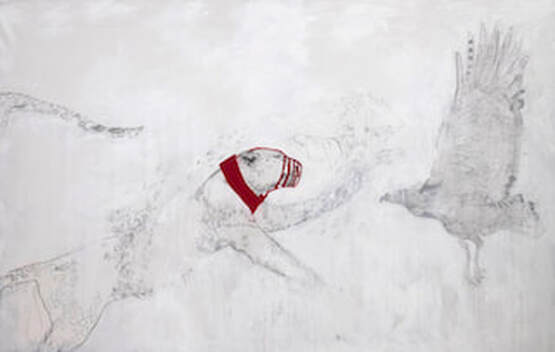
THE CAGE PAINTINGS SERIES
Lorna Marsh’s series Cage Paintings (above) is a meditation on the ways in which our actions marginalize nature. Whether through direct imprisonment or the confinement of cultural iconography, animals are categorized and contained, their natures sanitized. Through her stark imagery, Marsh seeks to depict the impact of mankind’s policies toward the natural world. From muzzled predators to rabbits encased by Easter eggs, the artist presents us with an alternative view of the consequences of our grand design.
Marsh’s collages of red devices symbolize the imposition of restraints and suggest the ramifications of the frameworks we foist upon nature. Through the very action of pasting a heavily wrought structure on her delicately lined images of animal, Marsh herself enacts the caging process. In the instance of the muzzled hunters, she suggests that the balance of predator and prey has been upended. If lions and wild dogs are no longer able to realize their evolutionary functions, what role do they play and how then are their former prey redefined?
Even something as seemingly innocuous as the Easter bunny is not free from examination in this series. Here, rabbits are shown imprisoned by cultural iconography. Our acceptance of a language in which rabbits and eggs are inextricably entwined redefines the nature of the animal. Man’s attempts to protect the natural world may also cause irrevocable shifts in the order of things. Marsh explores the plight of the rhinoceros, whose protectors have resorted to removing its horn to save the animal from poachers. In this case, we have neglected to consider the impact of our actions upon the species. At the same time, our conservational efforts are distilled, emphasizing the horn; the body of the animal remains vulnerable. Ultimately, Marsh is asking us to question the ways in which we have rationalized our treatment of animals. And, in doing so, she invites us to consider how our “caging” of nature has compromised our own natures.
About Lorna Marsh
|
Lorna Marsh was born in Cape Town, South Africa and is considered one of the most important female artists of our time. Her early art instruction included courses with visiting professors from the Royal Academy and she also attended the Art Institute in Chicago. Having lived on three continents, her work has been shaped by many influences, but primarily by the human condition, animals, cartoons, which is the focus of many of her paintings. Her figures sometimes depict man’s interaction with the animal world and nature in illuminating ways.
Marsh’s work is most closely aligned with German Expressionism and Surrealism. She has a love of line, which can be seen, in almost all her work. The surfaces are complex, often applied directly by hand, using a wide variety of media. Lorna Marsh’s work has been exhibited throughout the world, in solo shows in South America, Spain, the USA and South Africa and in- group shows in Italy and the USA. Her work is in corporate and private collections, most notably in Germany where she has a strong following, Canada, the USA and in South America. Including many important solo shows at the Florida Museum of Hispanic and Latin American Art, Miami, Florida, the Jacobo Borges Museum, Caracas, Venezuela, the Real Monastery of Santa Maria de la Valldigna Fundació Jaume II el Just, Valencia, Spain, the João Ferreira Gallery, Cape Town, South Africa, the Aldo Castillo Gallery, Chicago, Illinois, the Shanghai Art Fair, among many others. Lorna Marsh has been represented by the Aldo Castillo Gallery since 2000. |
CREATURES OF THE EARTH: The Art of Lorna Marsh by Robert P. Metzger, Ph.D.
The epic, ambitious paintings of Lorna Marsh deal with the continuous human condition which has relentlessly resisted discernible modification throughout the past millennium. Her thought-provoking meditations on how little the heart of man has changed after so many centuries is evident in her numerous series of paintings, including: "Man is the Trap Against Nature" (steel-jaw lion traps), "Tethered Flight" (kingfisher, sparrow hawk, and kestrel bound by string), "Cage" (muzzled animals), "Shrouded Visions" (draped people, animals, and landscapes)," Africa Within" (scavengers: jackal, hyena, dog, baboon, lion, and vulture), "Discarded Landscapes" (ecological warnings), "I am the Choicemaker" (Eve in the Garden of Eden), and "Firebirds" (conflagration of birds). Her unrestrained improvisation is apparent in her understated approach of eschewing the paint brush and applying her materials directly with her hands and arms. Using acrylic paint, oil stick, graphite, and wood stains and varnishes, she approaches each canvas with a masterful technique and ecstatic passion.
Marsh's astonishing series of paintings are cautionary tales, reminding the viewer of the pitfalls of an Orwellian group-think. Her work advocates strongly for the logic and necessity of courageous individuality. Throughout our long history, each emerging generation has struggled to affirm life's full possibilities and to regain anew their common humanity. Marsh is keenly aware of mankind's shared longing for belonging and better ways of living. Life's very precariousness underscores her intense connection for the "Everyman" and with all of God's creatures great and small.
Reforging the unity between art and meaningful existence, Marsh chronicles our mutual dreams and nightmares which expose our frailties and vulnerability. Her deep distress over human destruction of the earth and the subjugation of nature for self-centered greed place her in the vanguard responsible, principled artists worldwide. However, unlike the over-kill of much "in-your-face" overtly political art, Marsh's more subtle approach speaks to both the heart and the brain. Her quiet indignation is especially effective in exposing the evils of the catastrophic atrocities of war. The dark side of life is evident in many of her works, yet even the most brutal of these pictures contain a flicker of what Wordsworth referred to as "the still sad music of humanity." The universality of her voice is confirmed in these profound, brooding paintings and her background on two Continents has informed and enriched her ideas.
Marsh's figurative expressionist style, with its roots in German Expression and European Surrealism, is also informed by the work of Robert Motherwell, Cy Twombly, and Antonio Tapies. In much of her work, such as in the Eve series, the human face appears partially or even fully expunged, heightening the sense of universality through the body. The female nudes exhibit interior anguish and turmoil and display the enormous toll of their difficult struggle. Each figure is distorted for peak emotional impact and dramatic effect. The extraordinary animal paintings, largely drawn from her native South Africa, are imbued with a hallucinatory intensity and ferocity. She convincingly conveys the tension of movement and counter movement of African herd animals such as wild dogs, hyenas, and baboons who forage for food and survive by traveling in packs. These animals, surrounded with abstract swirls, becoming a part of the painterly background of barren landscape. Marsh is especially attracted to these animals because of their endurance from ancient times, their freedom, and their ability to withstand severely discordant conditions. These creatures are the antithesis of commercially
cute Disney animals. It is their very rough-hewn appearance that gives them a distinct dignity and nobility. Man's relationship with animals is a persistent and potent theme in Marsh's work, personifying the words from the Book of Job; "Ask the beasts and they shall teach thee, and the fowls of the air, and they shall tell thee." Marsh's images are a reminder of the beast within each individual and the divine spark in all living things.
ABOUT ROBERT METZGER
Robert Metzger, Director Emeritus of the Reading Public Museum, served in that capacity at the Aldrich Museum, theAllentown Art Museum, and the Stamford Museum and Nature Center and worked as Curator for W. Hawkins Ferry in Grosse Pointe, Michigan and for Lydia Winston Malbin and Richard Brown Baker in New York. He taught Art History at the University of Detroit and Bucknell University and studied at Columbia University, University of California, Los Angeles, Concordia College, River Forest, Illinois, Wayne State University, Detroit, Museum Management Institute, Berkeley, California, and the Victorian Society Summer School, London, U.K. He is the author of St. Petersburg Realism (U.S.S.R.), Ronald Reagan: American Icon, Abstract Expressionism Lives!, Edward Hopper: Early Impressions, Franz Kline: the Jazz Murals, and British Romantic Art and monographs on Arakawa, Nakian, Stamos, Boghosian, Tobin, Stubbs, Stuempfig, Murray, Namingha, Meneeley, Press, Coyer, and Strauser. In addition, he was the subject of the George Furth-Stephen
Sondheim Broadway musical Company.
The epic, ambitious paintings of Lorna Marsh deal with the continuous human condition which has relentlessly resisted discernible modification throughout the past millennium. Her thought-provoking meditations on how little the heart of man has changed after so many centuries is evident in her numerous series of paintings, including: "Man is the Trap Against Nature" (steel-jaw lion traps), "Tethered Flight" (kingfisher, sparrow hawk, and kestrel bound by string), "Cage" (muzzled animals), "Shrouded Visions" (draped people, animals, and landscapes)," Africa Within" (scavengers: jackal, hyena, dog, baboon, lion, and vulture), "Discarded Landscapes" (ecological warnings), "I am the Choicemaker" (Eve in the Garden of Eden), and "Firebirds" (conflagration of birds). Her unrestrained improvisation is apparent in her understated approach of eschewing the paint brush and applying her materials directly with her hands and arms. Using acrylic paint, oil stick, graphite, and wood stains and varnishes, she approaches each canvas with a masterful technique and ecstatic passion.
Marsh's astonishing series of paintings are cautionary tales, reminding the viewer of the pitfalls of an Orwellian group-think. Her work advocates strongly for the logic and necessity of courageous individuality. Throughout our long history, each emerging generation has struggled to affirm life's full possibilities and to regain anew their common humanity. Marsh is keenly aware of mankind's shared longing for belonging and better ways of living. Life's very precariousness underscores her intense connection for the "Everyman" and with all of God's creatures great and small.
Reforging the unity between art and meaningful existence, Marsh chronicles our mutual dreams and nightmares which expose our frailties and vulnerability. Her deep distress over human destruction of the earth and the subjugation of nature for self-centered greed place her in the vanguard responsible, principled artists worldwide. However, unlike the over-kill of much "in-your-face" overtly political art, Marsh's more subtle approach speaks to both the heart and the brain. Her quiet indignation is especially effective in exposing the evils of the catastrophic atrocities of war. The dark side of life is evident in many of her works, yet even the most brutal of these pictures contain a flicker of what Wordsworth referred to as "the still sad music of humanity." The universality of her voice is confirmed in these profound, brooding paintings and her background on two Continents has informed and enriched her ideas.
Marsh's figurative expressionist style, with its roots in German Expression and European Surrealism, is also informed by the work of Robert Motherwell, Cy Twombly, and Antonio Tapies. In much of her work, such as in the Eve series, the human face appears partially or even fully expunged, heightening the sense of universality through the body. The female nudes exhibit interior anguish and turmoil and display the enormous toll of their difficult struggle. Each figure is distorted for peak emotional impact and dramatic effect. The extraordinary animal paintings, largely drawn from her native South Africa, are imbued with a hallucinatory intensity and ferocity. She convincingly conveys the tension of movement and counter movement of African herd animals such as wild dogs, hyenas, and baboons who forage for food and survive by traveling in packs. These animals, surrounded with abstract swirls, becoming a part of the painterly background of barren landscape. Marsh is especially attracted to these animals because of their endurance from ancient times, their freedom, and their ability to withstand severely discordant conditions. These creatures are the antithesis of commercially
cute Disney animals. It is their very rough-hewn appearance that gives them a distinct dignity and nobility. Man's relationship with animals is a persistent and potent theme in Marsh's work, personifying the words from the Book of Job; "Ask the beasts and they shall teach thee, and the fowls of the air, and they shall tell thee." Marsh's images are a reminder of the beast within each individual and the divine spark in all living things.
ABOUT ROBERT METZGER
Robert Metzger, Director Emeritus of the Reading Public Museum, served in that capacity at the Aldrich Museum, theAllentown Art Museum, and the Stamford Museum and Nature Center and worked as Curator for W. Hawkins Ferry in Grosse Pointe, Michigan and for Lydia Winston Malbin and Richard Brown Baker in New York. He taught Art History at the University of Detroit and Bucknell University and studied at Columbia University, University of California, Los Angeles, Concordia College, River Forest, Illinois, Wayne State University, Detroit, Museum Management Institute, Berkeley, California, and the Victorian Society Summer School, London, U.K. He is the author of St. Petersburg Realism (U.S.S.R.), Ronald Reagan: American Icon, Abstract Expressionism Lives!, Edward Hopper: Early Impressions, Franz Kline: the Jazz Murals, and British Romantic Art and monographs on Arakawa, Nakian, Stamos, Boghosian, Tobin, Stubbs, Stuempfig, Murray, Namingha, Meneeley, Press, Coyer, and Strauser. In addition, he was the subject of the George Furth-Stephen
Sondheim Broadway musical Company.
